We asked 19 experts to share their social media trends and predictions for 2025 to enhance your strategy.
Here are the tips they shared and how to apply them.

Trend #1. The rise of silent social platforms
When Clubhouse launched in 2020, it had a meteoric rise, reaching 6 million users by February 2021. Yet, less than a year after its peak, Clubhouse lost 80% of its active user base (source).
Many brands learned an important lesson then: quick platform popularity doesn't guarantee sustained success.
Now, a new wave of social platforms, such as Bluesky, is emerging with a radically different approach.
I think there's going to be a rise of 'Silent Socials' as people seek balance, platforms or content types catering to less overwhelming, quieter engagement could emerge. It will shift to platforms with less noise and more focus on intentional connection. - Romy Ledder, the Social Media Manager and Founder of Narwhal Communications.
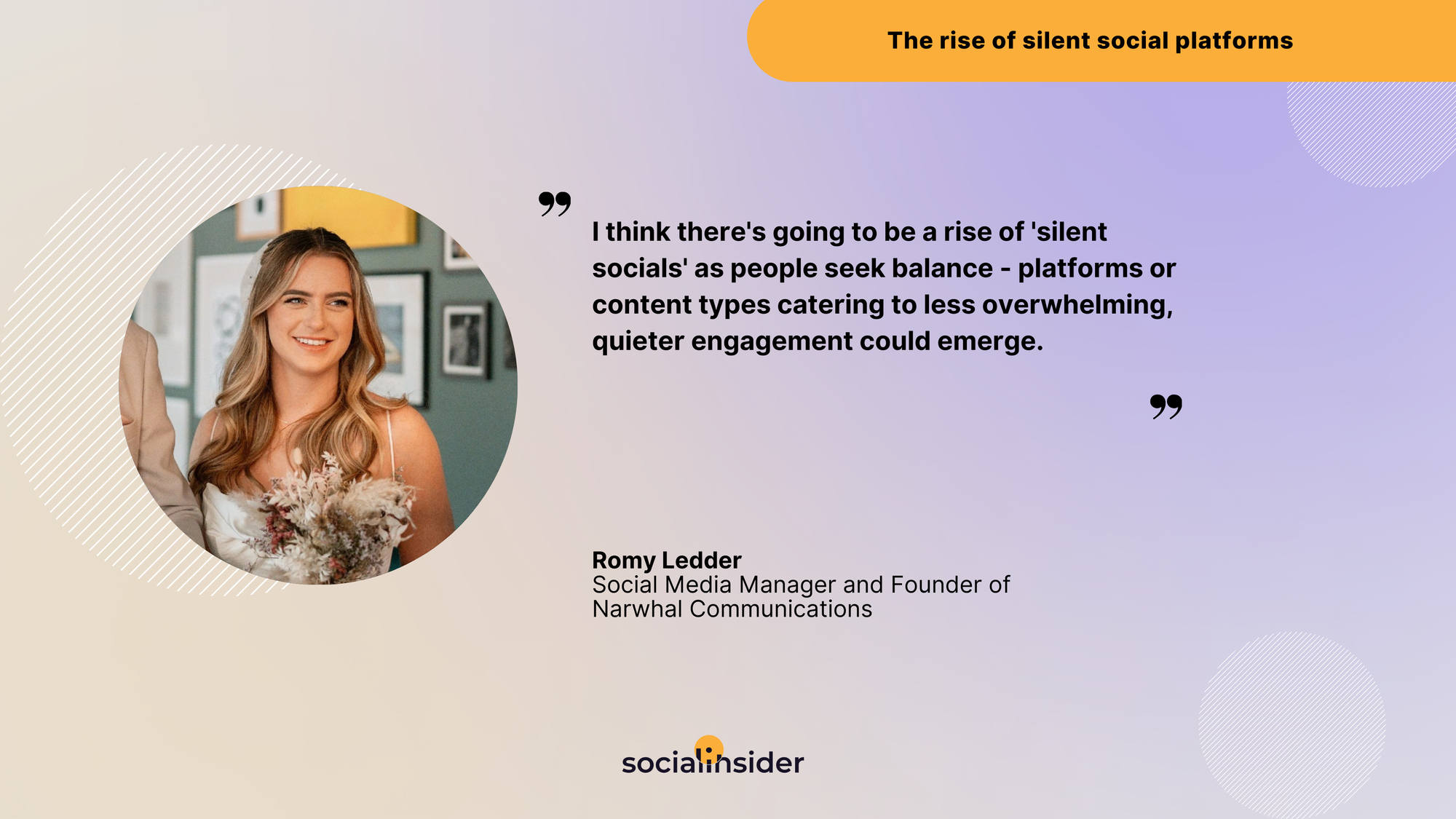
This evolution extends beyond just new names in the market. As Oksana Danshyna, Director of PR, Communications & Social Media at Cloudways by DigitalOcean, explains:
Brands will explore new platforms they haven't been on before, partly as a way to optimize resources and focus on quality content and real results. There also could be a shift towards their audiences, like moving from X to Bluesky or Threads, or wherever people are genuinely active.

As new social media platforms enter the scene in 2025, should you give them all a try? Here are a few best practices for platform selection:
- Monitor where your target audience actively engages rather than following platform hype.
- Test new platforms with small-scale content pilots before full commitment.
- Develop platform-specific content strategies rather than cross-posting.
- Maintain a consistent brand voice while adapting to each platform's unique features.
Trend #2. The merge of physical and digital brand experiences
The lines between digital presence and physical brand experiences are dissolving rapidly in B2B marketing.
While consumer brands experiment with retail activations, B2B companies are discovering that their most powerful social media moments often stem from real-world professional interactions, from industry conferences to client workshops.
Cultural Resonance Specialist Camille Felicity explains the shift:
Social media is returning to its roots, enhancing physical experiences with real-time connection and shared creativity. Gen Z's desire for connection is reigniting the power of fandom as a marketing tool, where shared experiences drive deeper engagement.
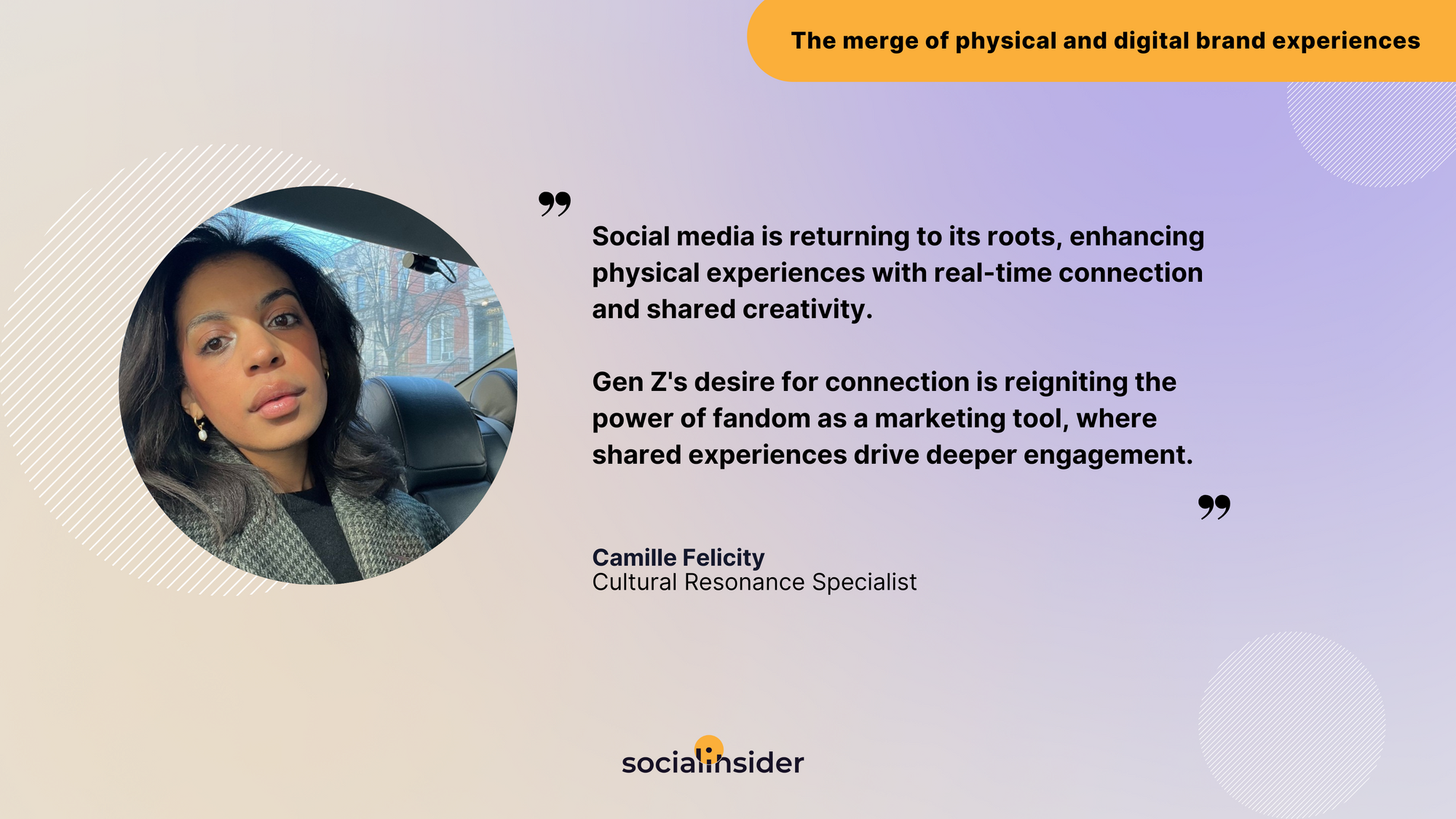
Sophie Miller, director at Pretty Little Marketer, reinforces this perspective with a practical insight:
How users value experiences as their new currency, over the obvious sales pitch — whether it's through employee-generated or user-generated content, or by blending the physical and digital worlds, makes it obvious brands need to create memorable moments that resonate with their audience.

This emphasis on memorable experiences aligns with the growing importance of creative content. As Jenn Crim, Sr. Manager of Social Media Strategy, notes:
I think creative content will become king. Outside of trends or content across brands that is similar/the same theme, teams like Dunkin' and their 'spider donut' content will reign supreme. There's a lot of noise of there to break through on social media - and creativity will be key in that for sure.
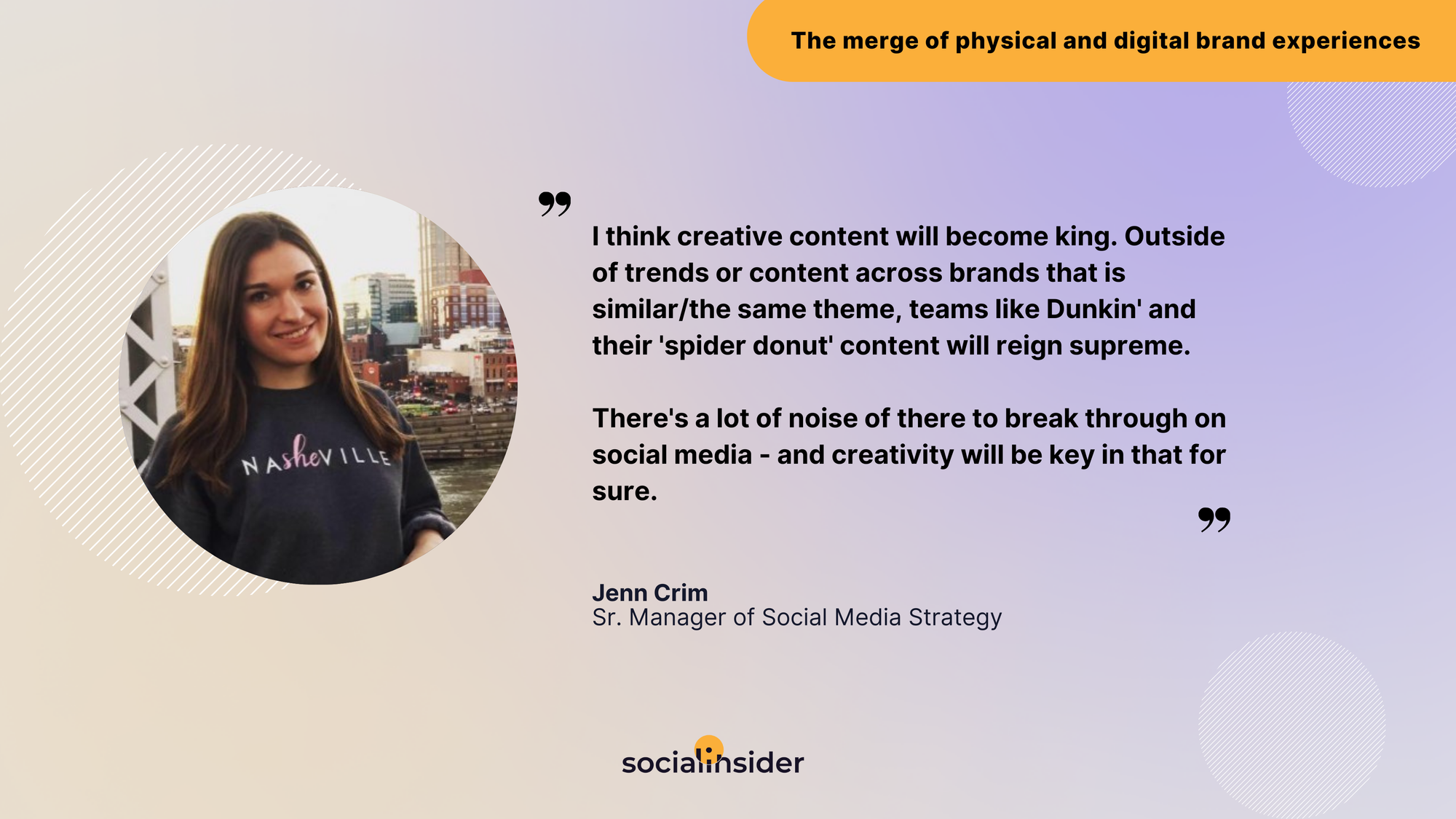
Want to give hybrid experiences a try in 2025? Here are a few ideas you can use as a starting point:
- Create shareable moments in physical locations specifically designed for social media, such as interactive product demos, creative conference booth setups, or innovative office spaces that showcase company culture.
- Develop exclusive content that only unlocks at physical locations.
- Integrate user-generated content from live events into your digital strategy.
- Build community-driven challenges that bridge online and offline experiences.
Trend #3. The shift to purpose-driven marketing
Neutral corporate positioning is no longer a thing people enjoy (was it ever?).
A recent AMA-NY study found that over 70% of buyers prefer companies that prioritize socio-political issues and are willing to pay a premium for responsible business practices.
This shift has transformed purpose-driven marketing from a nice-to-have into a strategic imperative.
I bet brands would thrive by embracing purpose-driven marketing (showcasing genuine commitments to social, environmental, or cultural causes) while leveraging AR, VR, and AI to create immersive, experiential campaigns. - Marketing and Social Strategy Manager Brianne Cail.

And this evolution comes with heightened scrutiny. As Social Media Specialist Shahveer Imran observes:
Audiences are more socially conscious than ever. In 2025, brands will need to show—not just tell—how they align with causes like sustainability, inclusivity, and mental health. But beware of performative activism; authenticity is non-negotiable.
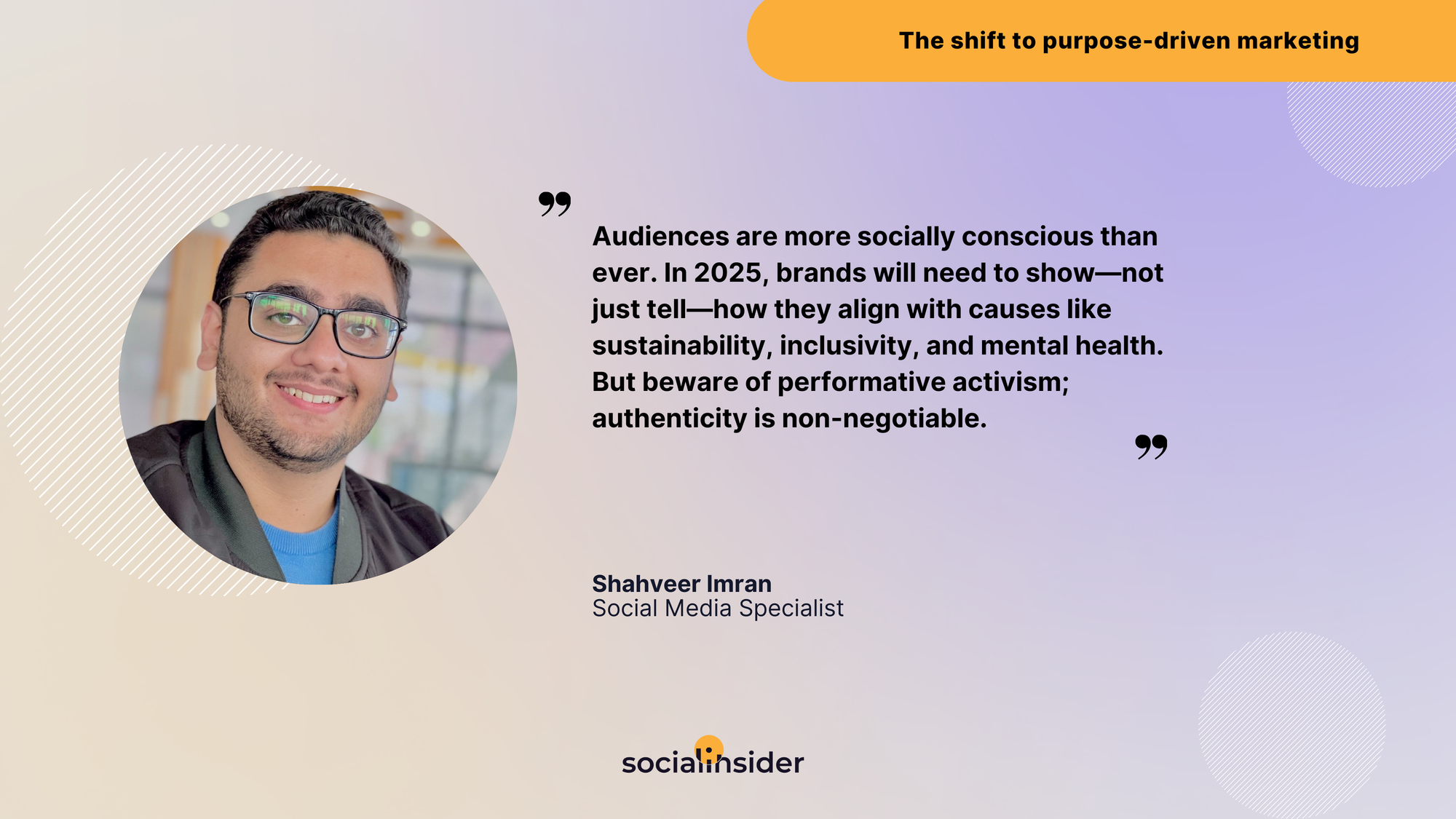
How can your brand authentically champion your values?
- Integrate cause-related content naturally into your regular content mix.
- Highlight employee involvement in corporate social responsibility initiatives.
- Partner with credible organizations that align with your values.
- Create educational content that helps your audience understand complex social issues.
Trend #4. The de-influencing movement comes to B2B
Traditional influencer marketing is facing an unexpected challenge: authenticity fatigue. As sponsored posts flood social feeds and one in five social media users consider themselves influencers, a countermovement called "de-influencing" is gaining momentum.
De-influencing is a social media trend that gained traction in 2023, particularly on platforms like TikTok, where creators discourage audiences from buying overhyped and unnecessary products. The trend promotes mindful spending and skepticism of traditional influencer marketing.
Sophie Miller observes the shift:
De-influencing makes it clear that consumers are becoming more discerning, and they're not buying into the hype anymore — forcing brands to rethink their strategies.
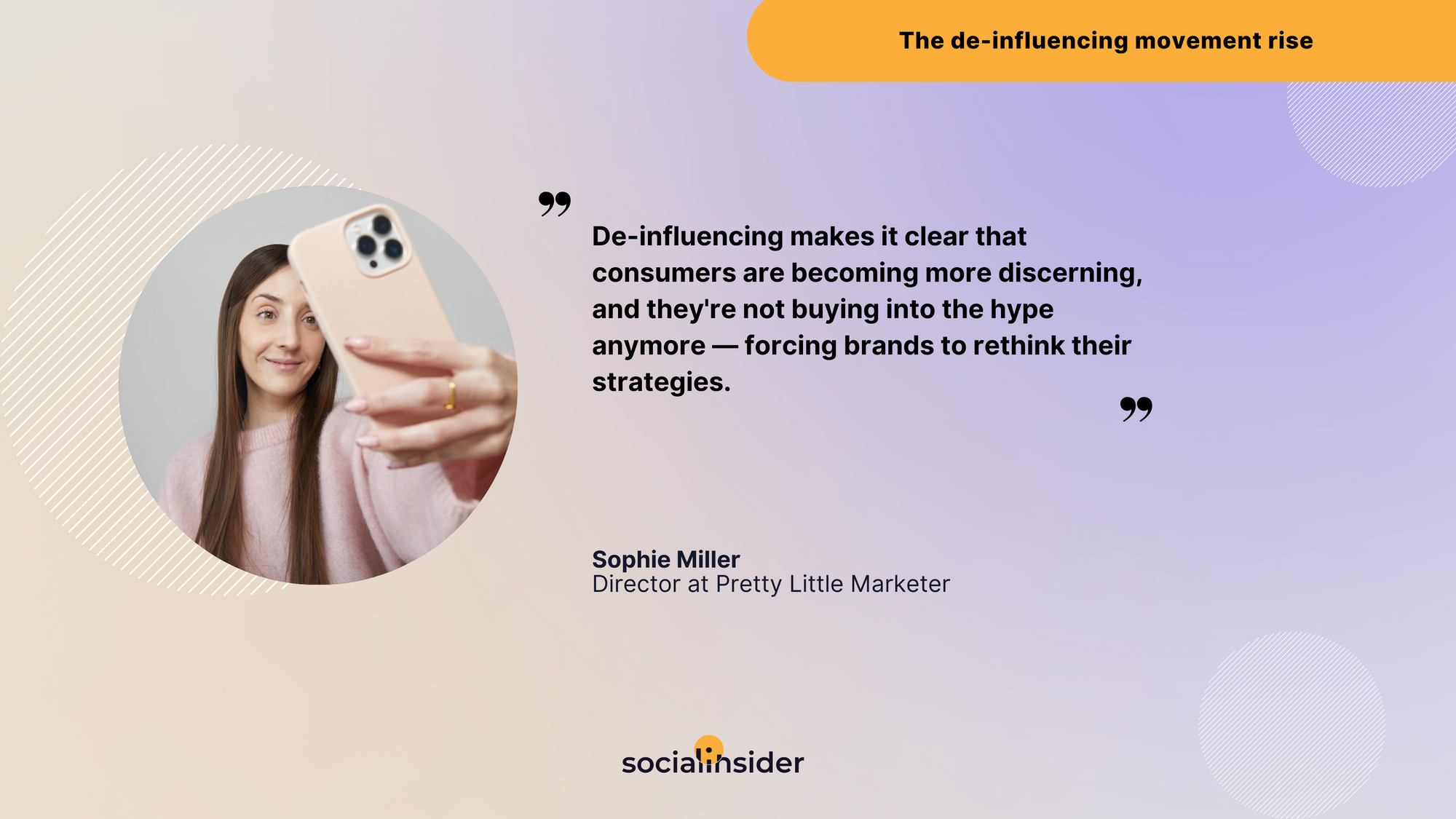
Digital Marketing Strategist Alexandra Nicolae adds depth to this trend:
The influencer era is said to be sunsetting for a while, and the biggest shift we will see is brands sending PR packages directly to consumers, without taking a large social media following into account. This circles us back to TikToks made by people with less than 1k followers who deliver a genuine impression and feedback on products.
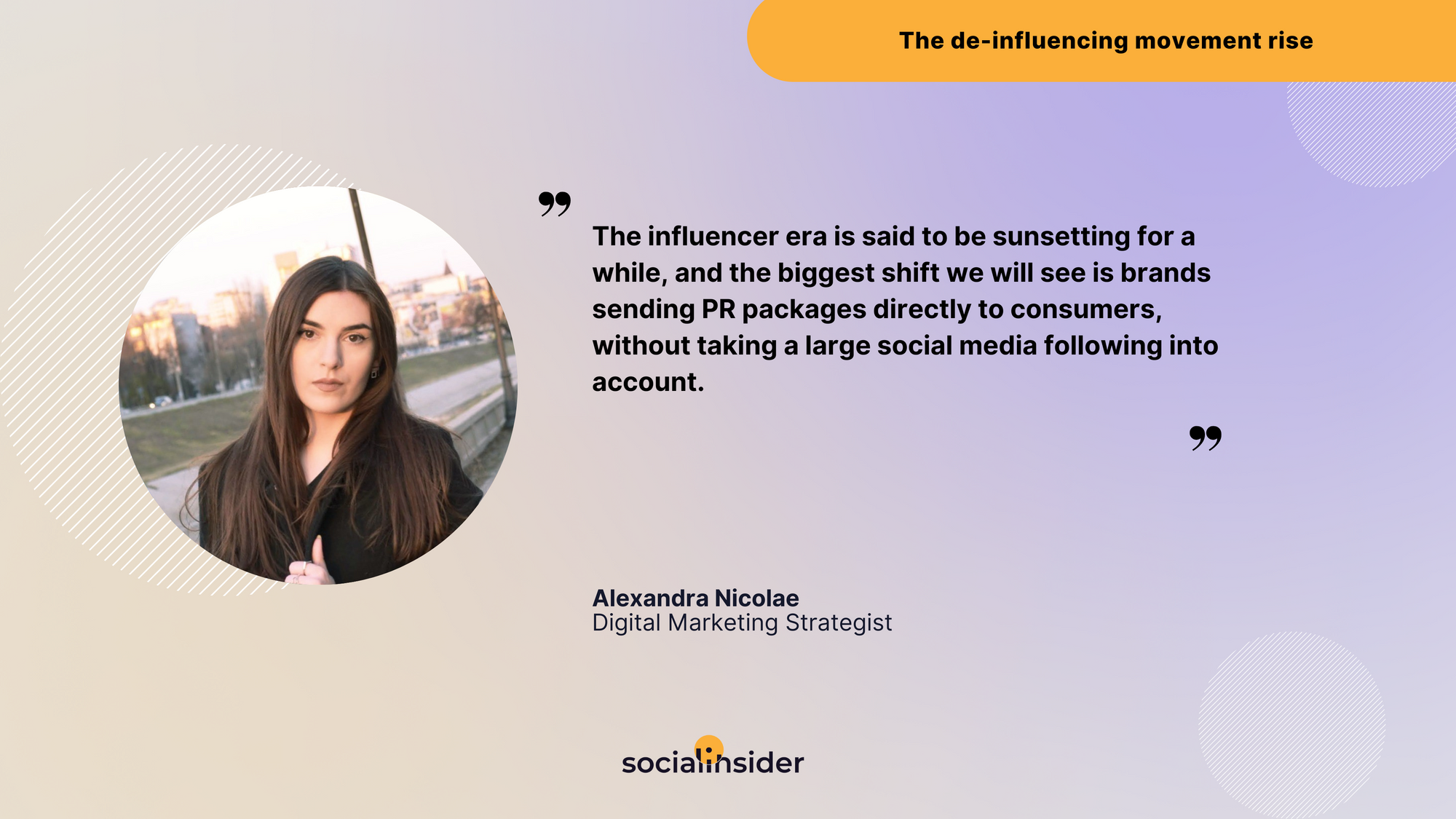
De-influencing challenges brands should focus on to provide genuine value if they want to be believable in 2025:
- Work with micro-experts with deep industry knowledge rather than a broad reach.
- Create employee advocacy programs to trigger genuine brand storytelling.
- Develop transparent case studies that include both successes and challenges — and get clients involved in the process.
- Build relationships with industry SMEs who naturally use your products.
Trend #5. The focus on private communities
Marketers are shifting their focus from broadcasting to thousands to nurturing hundreds of engaged social media community members. This trend reflects a growing understanding that depth of engagement often matters more than reach.
After all, a dialogue with a group of friends feels more genuine and authentic and triggers more engagement than speaking in a large auditorium, doesn't it?
Sophie Miller shares a key insight from recent trends:
The power of community management has shown it's the real MVP of 2024, as the winning brands this year prioritized memories over masses.
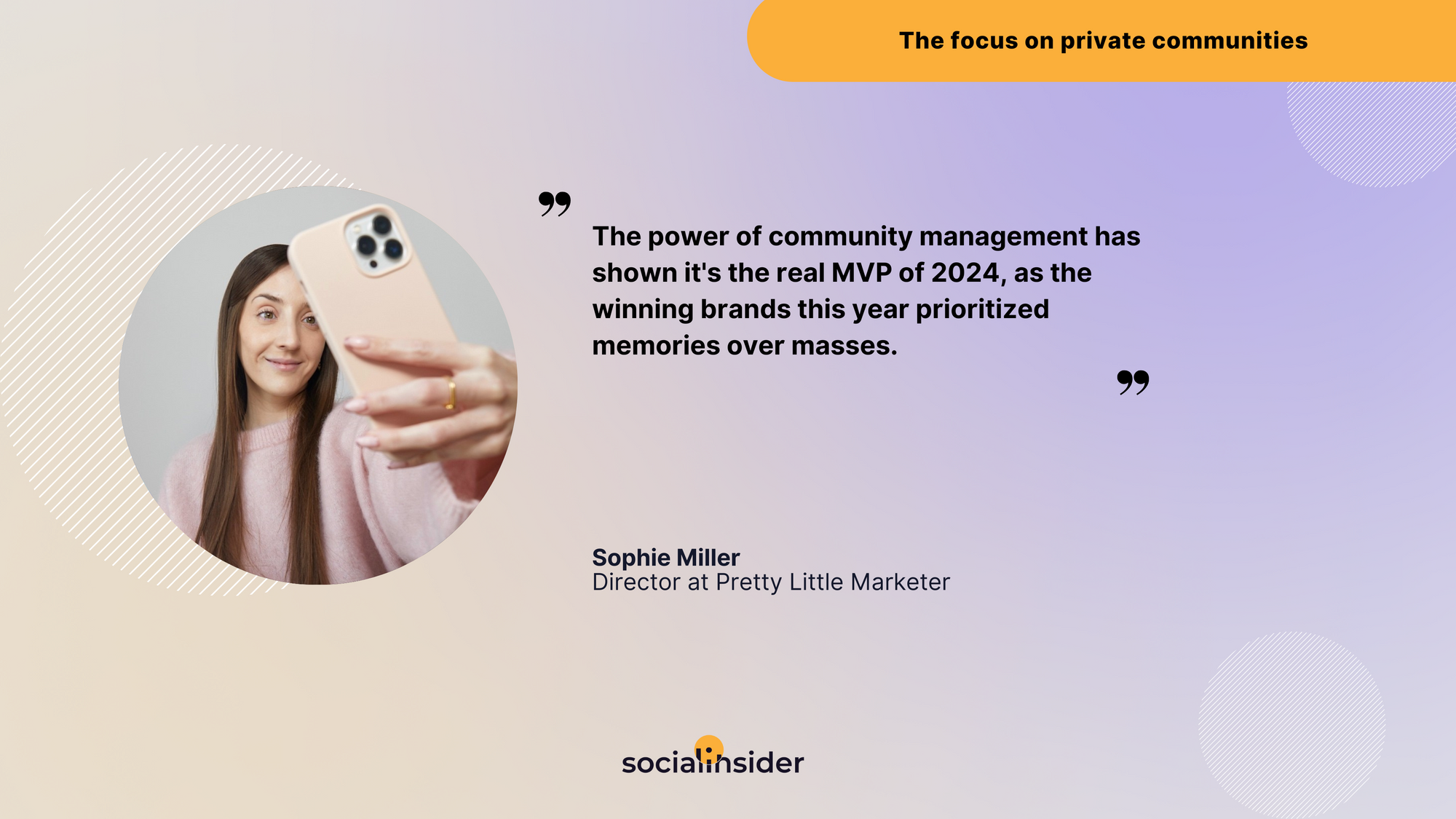
If you haven't already, 2025 should be the year in which you build and nurture private communities around your B2B brand:
- Create exclusive spaces for in-depth industry discussions, such as invite-only LinkedIn groups, moderated Slack channels, or members-only webinar series where executives can speak candidly.
- Develop member-only content that addresses specific pain points, like detailed case studies, early access to industry research, or expert Q&A sessions with your technical team.
- Foster peer-to-peer connections through monthly virtual roundtables, workshops, or industry-specific mastermind groups.
- Implement regular feedback loops, including quarterly surveys and one-on-one interviews with power users.
Trend #6. The resurgence of nostalgia marketing
While tech races forward, marketing is taking a strategic step back. The surge in nostalgia marketing isn't just about retro aesthetics but about tapping into a psychological need for familiarity.
The Social Media Manager and Founder of Narwhal Communications Romy Ledder observes:
I think nostalgia marketing will continue into 2025. With so much emphasis on new tech, brands embracing retro themes (text-heavy MySpace-style interfaces or Y2K visuals) could see a resurgence.

Nostalgia marketing in the B2B space is less common than in B2C, but it can be a powerful tool when used strategically. Take a cue from Microsoft's revival of Clippy or Adobe's 90s-inspired designs.
How can you make nostalgia marketing work for your brand?
- Adapt retro design elements for social posts, such as Windows 95-style UI frames for product screenshots, old-school cursor animations in Reels, or dial-up internet loading bars for LinkedIn carousels.
- Reference memorable social media milestones, like the first viral tweet in your industry or early social media profile layouts.
- Create "throwback" content series, such as showcasing old product versions or polls comparing past vs. present industry practices.
- Use vintage-inspired filters and effects in your social content, like VHS-style video effects for product demos or retro typography in carousel posts.
Trend #7. The consolidation of LinkedIn-first B2B strategies
LinkedIn isn't just another social media platform — it's the platform for B2B companies to generate awareness and quality leads.
According to our LinkedIn benchmarks report, the platform continues to drive engagement in 2024 and beyond, with a 44% increase in this metric year after year.
Based on the data, here's how B2B brands can maximize their LinkedIn marketing:
- Prioritize multi-image posts in your content strategy, as they achieve the highest engagement rate. Create carousel-style updates featuring industry insights, step-by-step guides, or product showcases.
- Leverage native documents by sharing original research, whitepapers, or case studies directly on the platform rather than as external links.
- Balance your content mix with standalone image posts and video content, using both for different storytelling purposes.
- Though simple text-only updates show a lower engagement rate, don't dismiss them. Get inspiration from brands that generate a lot of LinkedIn engagement by writing short, snappy text-only posts.
- Test LinkedIn polls — while they show lower overall engagement, they're effective for generating immediate community interaction and gathering market insights.
Trend #8. The power of employee content
The most authentic voices for your brand aren't coming just from your marketing department but from your entire company.
Employees are the new face of B2B communication, helping to build genuine trust with other businesses. After all, studies show that 79% of companies with employee advocacy programs saw increased online visibility, while 65% experienced improved brand recognition.
Oksana Danshyna, Director of PR, Communications & Social Media at Cloudways by DigitalOcean, emphasizes this trend:
Brands will be working more with content creators or involving employees and brand ambassadors to boost authenticity. With the rise of AI-created content, it's becoming even more important for brands to stand out by using real voices. That human touch makes the difference in creating content that feels genuine and relatable.

This trend extends beyond casual social sharing. As Shahveer Imran notes:
The focus will shift further toward individuals—not just influencers but also employees, founders, and industry experts. People want to connect with relatable voices, not faceless logos. Brands will encourage their teams to build authentic personal brands on LinkedIn, Instagram, and even TikTok. The result? A human-first approach that builds deeper trust.
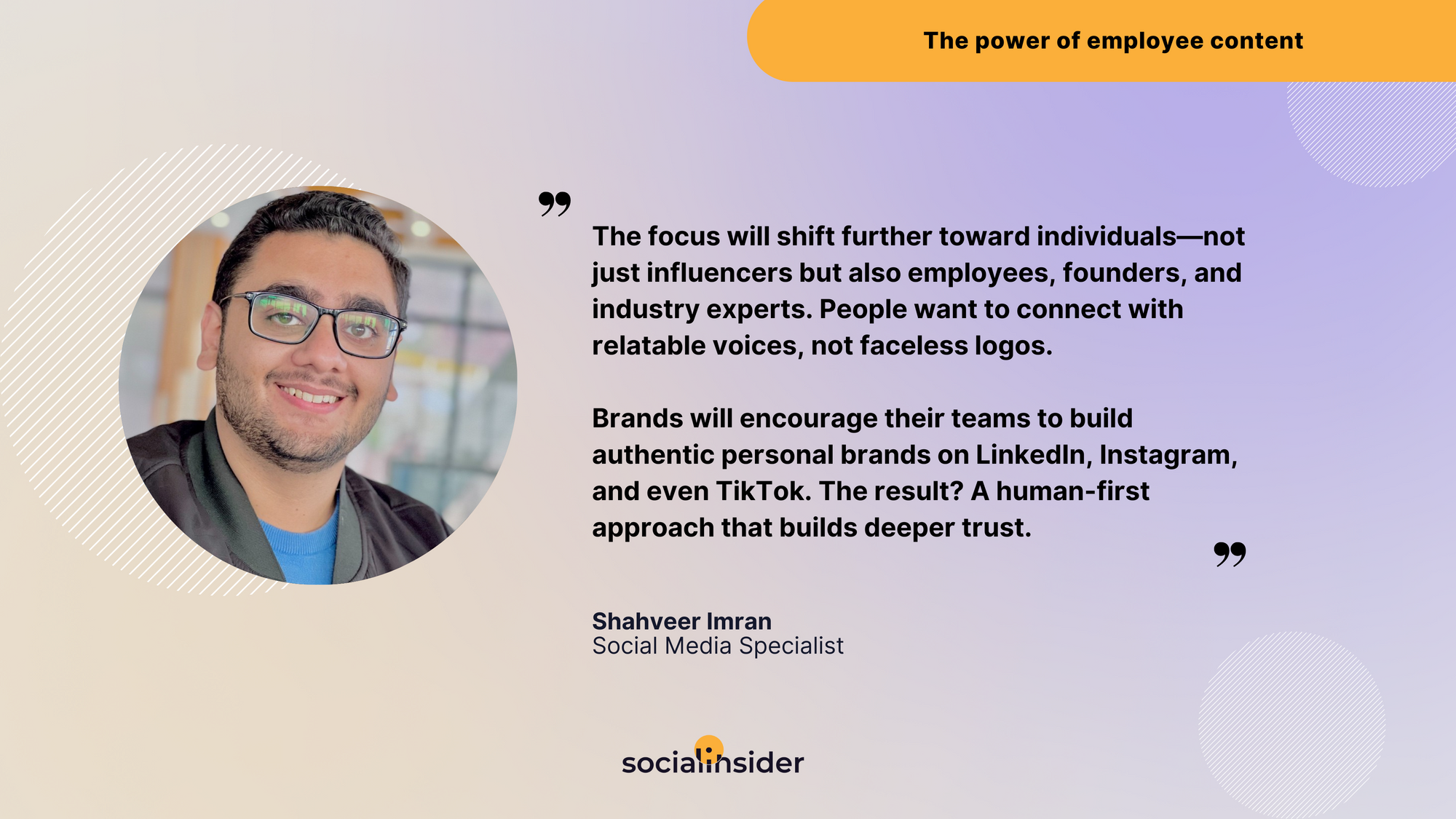
Here are a few ways to activate employee voices effectively on social media in 2025:
- Create an employee advocacy program with clear guidelines and content suggestions, such as weekly trending topics employees can share their perspectives on.
- Develop a content library of shareable assets, including industry insights, thought-leadership pieces, behind-the-scenes photos, and company culture moments.
- Launch an internal newsletter or a dedicated channel on your company chat highlighting top-performing employee posts and sharing engagement tips.
- Provide regular training sessions on personal branding and platform-specific best practices.
Trend #9. The increased popularity of brand characters
The face of social media is changing — literally. Companies are moving away from faceless corporate accounts to spotlight real people who personify their brand values and expertise.
An example of this comes from brands like Semrush with their character Chris on Instagram & TikTok. This demonstrates that even technical B2B products can benefit from a more light and fun personified approach.
These characters aren't traditional spokespeople or mascots. Instead, they're authentic team members who become the consistent voice and face of the brand, making technical content more accessible and building genuine connections with audiences.
This social media trend addresses a crucial challenge in social media: humanizing complex products and services while maintaining professional credibility.
Here's how to leverage the power of brand storytellers:
- Select team members who naturally embody your brand values and have genuine expertise in your industry.
- Create content formats that showcase their unique personality while delivering valuable insights.
- Develop social media content series that leverage their specific expertise and communication style.
- Enable direct engagement with audiences through Q&As, live sessions, and community discussions.
Trend #10. The meme strategy evolution
Memes can get a good chuckle out of people, but they can also help brands amplify their messages in a light and funny way. And while this is typically a content format employed in B2C, more and more B2B marketers are starting to integrate memes into their social media mix.

Why?
Memes help turn technical B2B content into easily digestible and engaging social posts. They humanize brands and make them more approachable. Not last, memes are particularly effective at driving organic reach.
Want to test the power of memes in 2025?
- Track viral trends and industry-specific moments worth commenting on.
- Build a library of industry-specific templates that can be quickly customized for timely reactions to news and trends.
- Develop a "meme voice" that balances professional insight with humor appropriate for your industry.
- Test different memes across platforms to identify what resonates with your audience.
- Use memes strategically as part of a wider and diverse content mix — don't let them overpower your feed, or you might get the opposite effect.
Trend #11. The rise of strategic influencer co-creation
The role of influencers is transforming - from simple promoters, they are now becoming strategic business partners. After all, authentic influence comes from genuine involvement in brand strategy and content creation.
Professional athletes who reach "celebrity status" are leading this change, as Michael Mims, Chief Brand Officer + Social Media Strategist, observes:
I'm hoping more athletes, celebrities, and successful founders continue to bring on dedicated content creators to help them capture their lives in a very real way. I think there is something to the 'Athletepreneurs' where personality will attract brand partnerships just as much as performance.
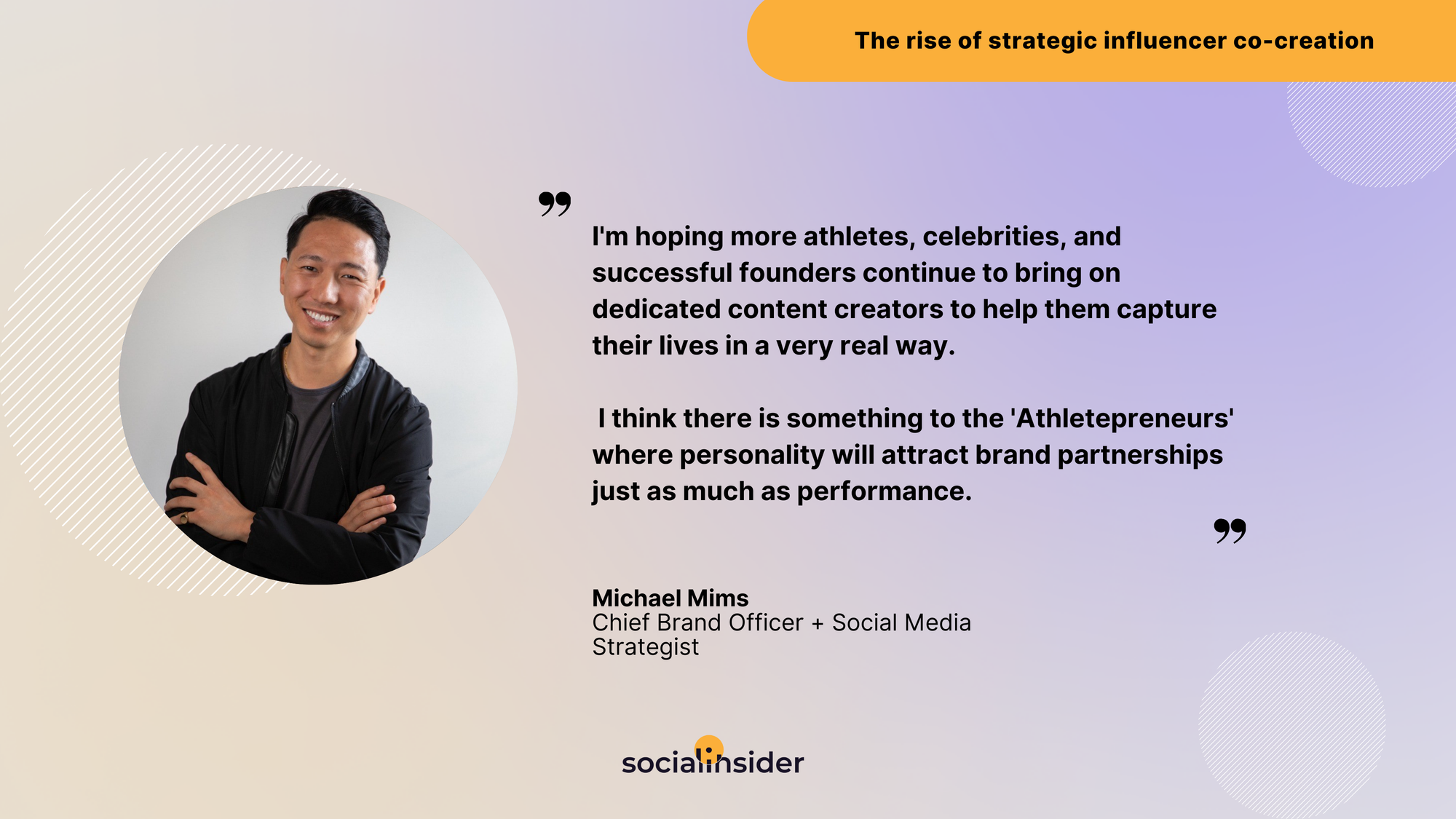
This collaborative approach is reshaping influencer marketing. As Social Media Specialist Shahveer Imran notes:
Influencers aren't just promoting anymore — they're co-creating campaigns. Expect more brands to treat influencers like creative partners, involving them in strategy, content ideation, and execution. This collaborative approach feels genuine and is far more impactful than traditional ads.
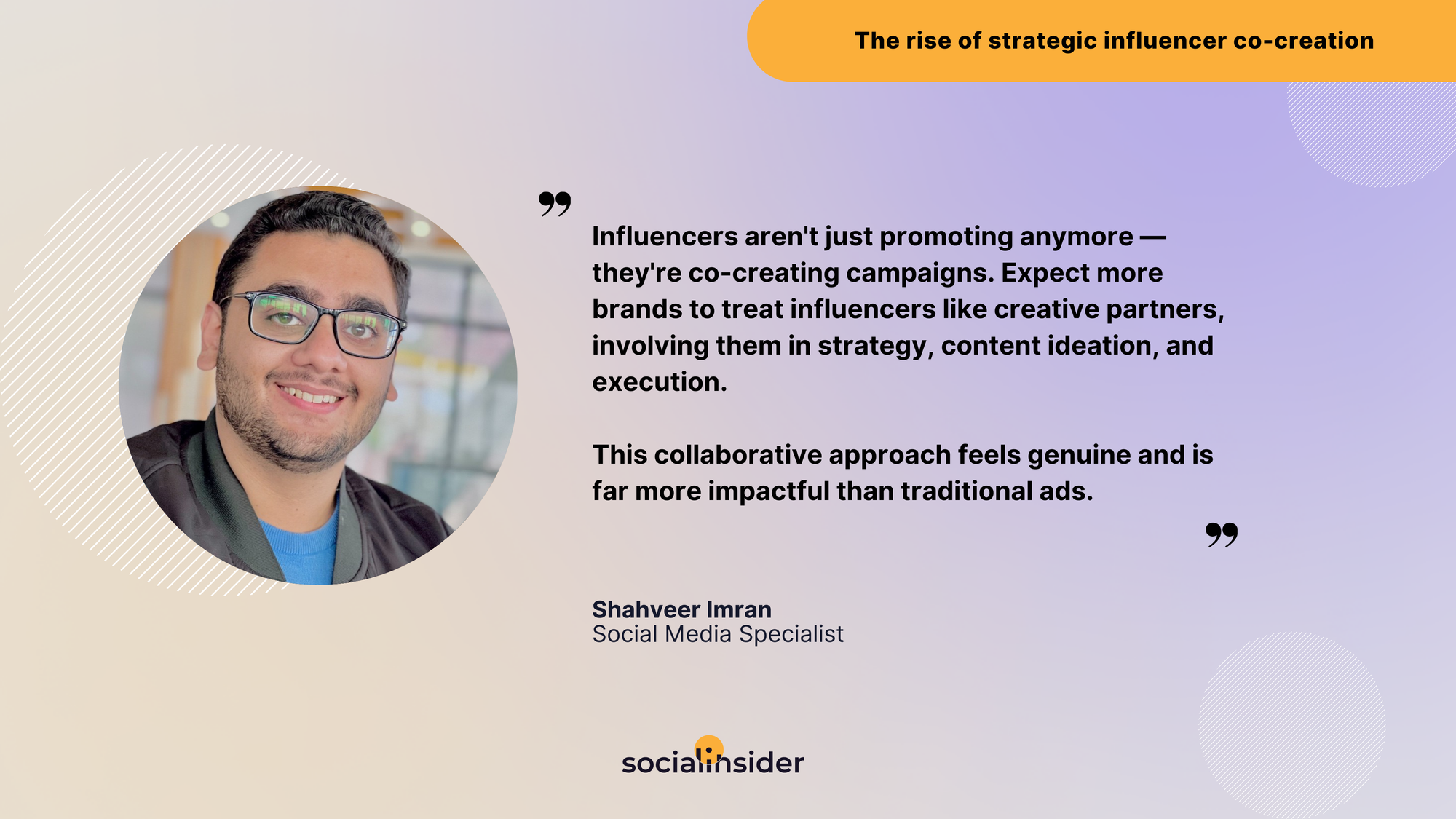
Carmen Collins, Director of Social Media for Generac Power Systems, adds another dimension:
My biggest prediction for the upcoming year is the rise of the independent journalist creator. Media trust is abysmal. Under the Desk News and creators like her are becoming the go-to source of information from an entire generation (plus others.) I think this is important for brands to recognize, as they seek to build trust.
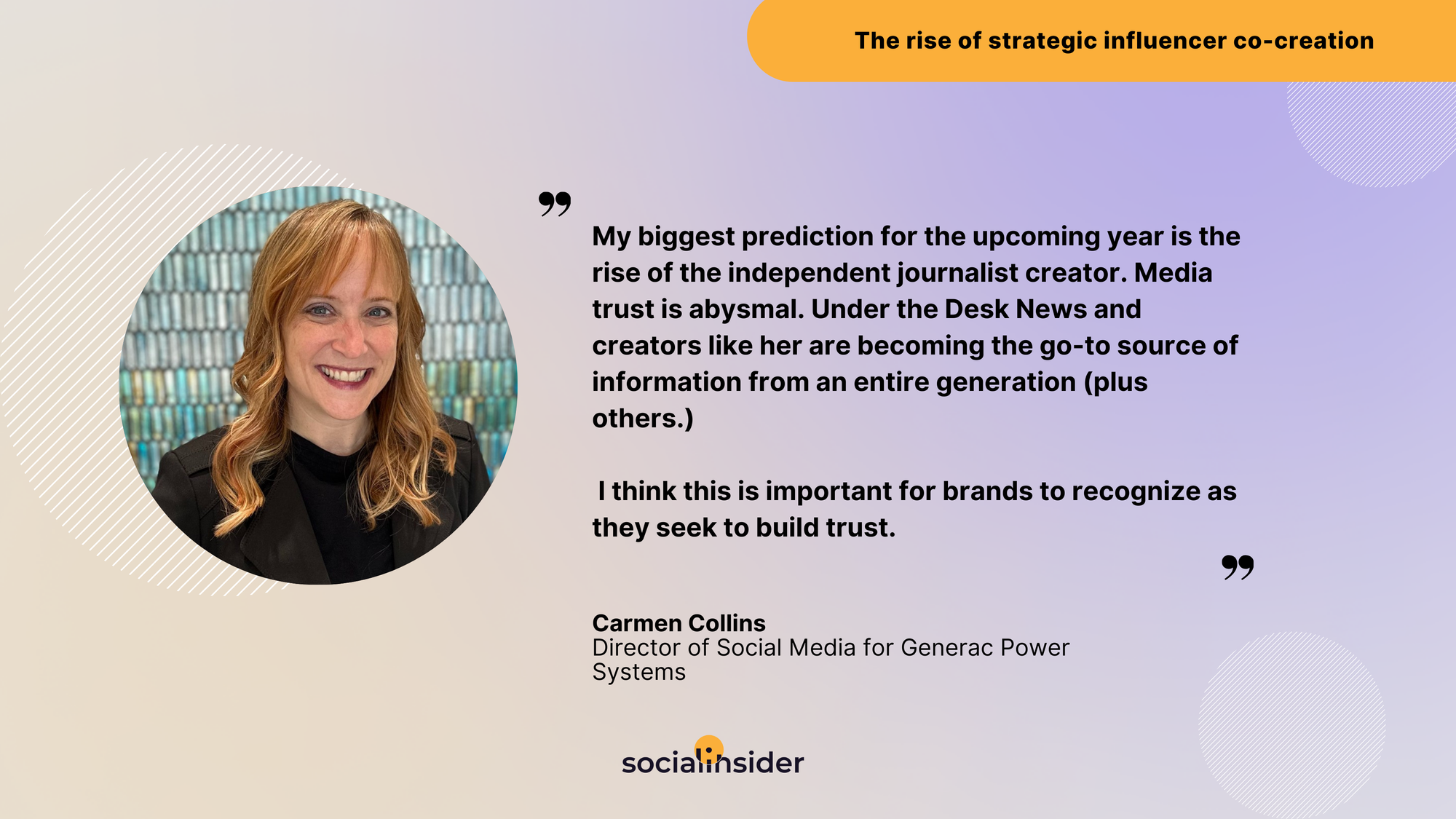
Time to rethink and reshape your influencer partnerships? A few things to put on your 2025 to-do list:
- Involve influencers in early-stage content development so they feel more invested in the outcome.
- Create long-term ambassadorship programs instead of one-off promotional campaigns.
- Develop co-branded content series that showcase both brand and influencer expertise.
- Build exclusive communities where influencers can connect with your brand's audience directly.
Trend #12. The TikTok search overtake
TikTok is no longer just for entertainment. It's becoming the go-to search engine for a new generation of decision-makers (hello, Millennials and ambitious Gen Z folks!).
As Digital Marketing Strategist Alexandra Nicolae emphasizes:
TikTok will surpass Google as the main search engine, with user-generated content being worth more than brand-placed videos or paid influencer reviews.
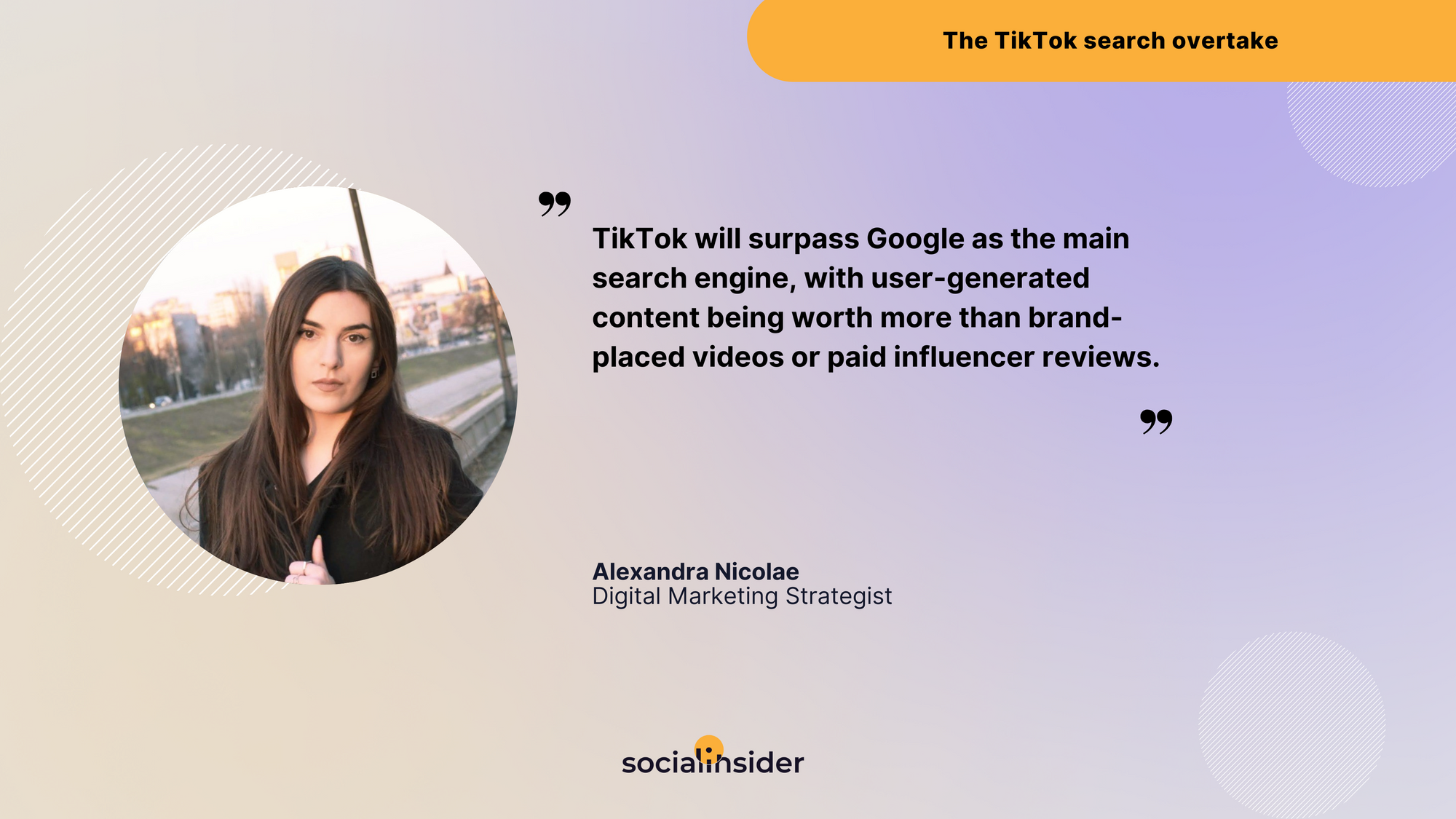
Don't discard Google just yet. But you should definitely start optimizing your social media SEO in 2025:
- Create educational content that answers common industry questions in your niche.
- Optimize video captions with searchable keywords and industry terminology.
- Develop series-based content that covers specific topics in depth.
- Use trending audio strategically to boost visibility while maintaining professionalism.
- Build a consistent posting schedule focused on your area of expertise.
- Leverage the power of brand characters and internal advocates to make communication believable and relatable.
Trend #13. The Gen Z focus in B2B
Speaking of TikTok marketing and younger generations, social media managers will be increasingly adapting their strategies in 2025 to better connect with Gen Z professionals — who are entering the workforce and increasingly influencing business decisions.
Social media specialists are finding that Gen Z's expectations for business content mirror their personal content preferences: authentic, value-driven, and straight to the point. They're the first generation to grow up entirely in the digital age, and their approach to business information gathering and decision-making reflects this native digital fluency.
This demographic shift is forcing companies to rethink traditional communication approaches.
A few ways for brands to connect with Gen Z professionals:
- Create mobile-first, snackable content that delivers immediate value.
- Develop educational content series that blend entertainment with practical insights.
- Showcase real employee experiences and behind-the-scenes glimpses of company culture.
- Focus on sustainability and social responsibility initiatives that matter to younger professionals.
- Build interactive content experiences that encourage participation and feedback.
- Stay on top of trends, but only mingle when relevant — beware of Gen Z's heightened sense of cringe.
Trend #14. The quest for authenticity
Raw, unfiltered content is slowly but surely replacing polished corporate messaging in social media marketing.
As Social Media Content Developer Muhammad Abdullah Imran Tahir observes:
In 2025 the same trends seem to be continuing with a renewed focus on authentic social-first content, as opposed to repurposing of branded content and TVCs.
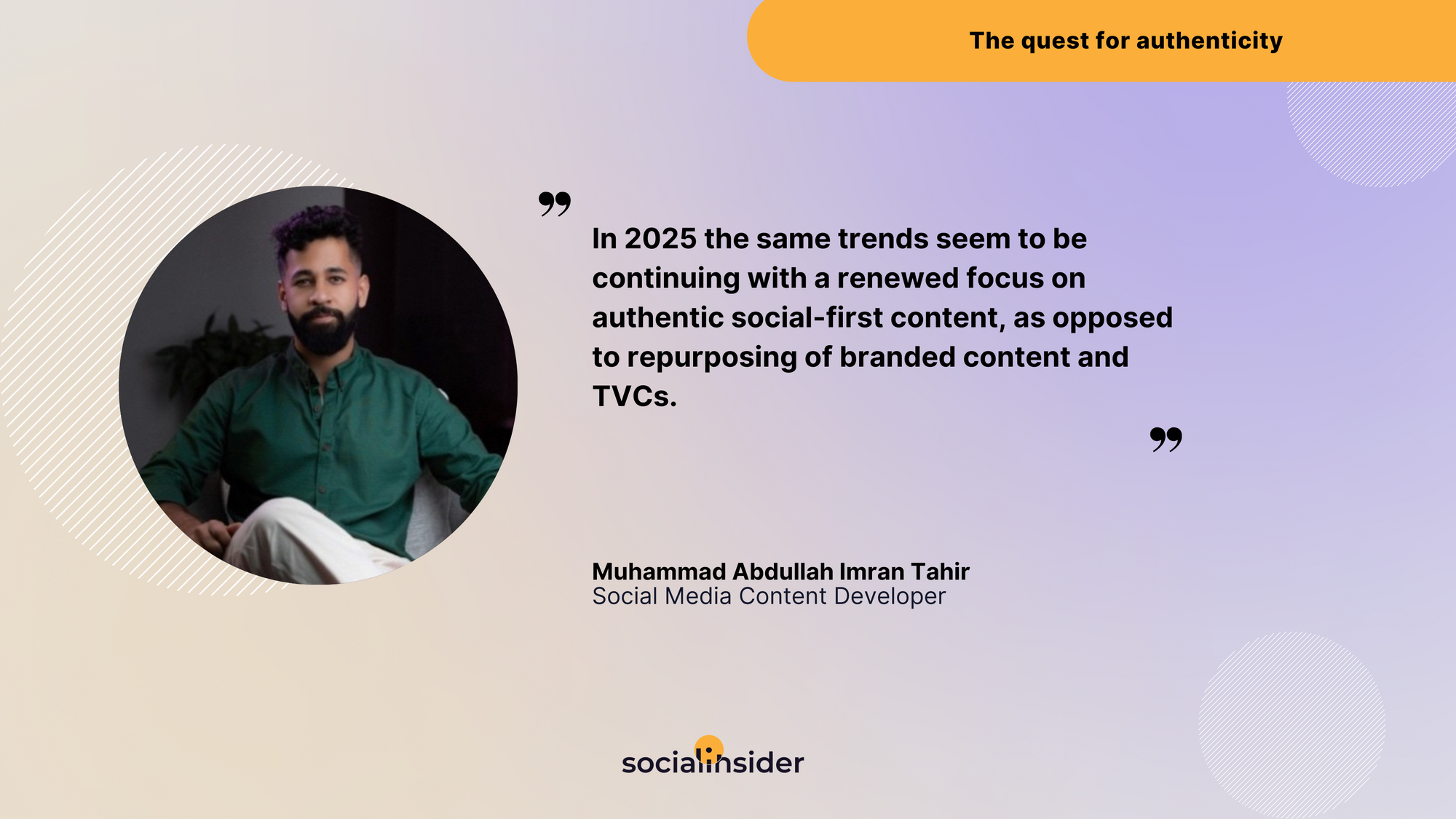
Digital Marketing Strategist Alexandra Nicolae reinforces this shift:
Genuine videos and authenticity will take the lead in terms of dictating what is consumed and bought.
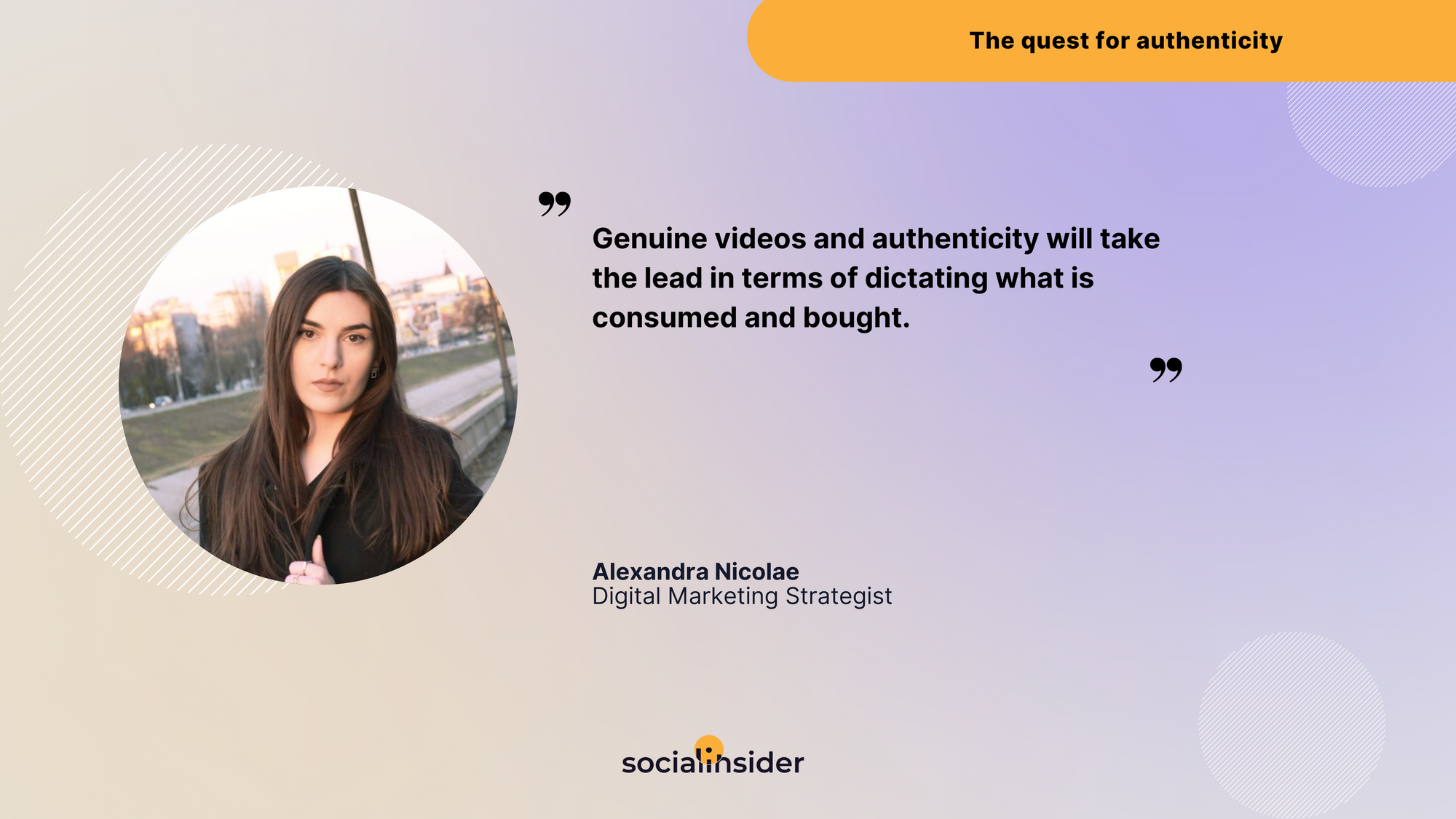
This evolution is particularly evident in video content. As Social Media Specialist Shahveer Imran notes:
Forget overproduced perfection; it's time to embrace raw, unhinged content that feels authentic. Livestreams, behind-the-scenes clips, and day-in-the-life videos are expected to dominate. People are tired of filters—they crave realness. Brands that embrace this will feel more approachable.
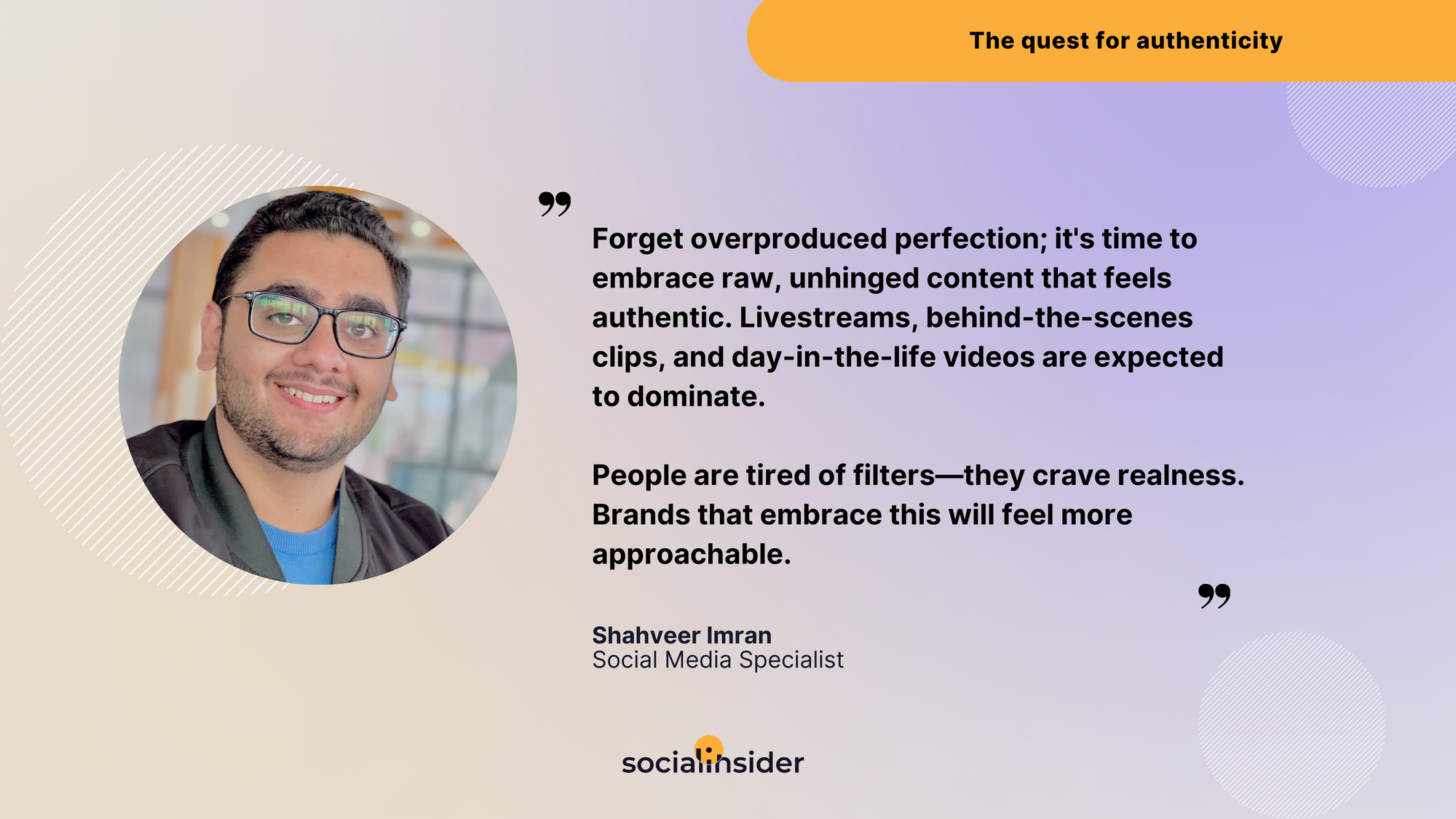
It's time to embrace rawness and authenticity in your 2025 social media calendar — yes, even if it makes you a bit uncomfortable:
- Share real customer testimonials and user experiences without heavy editing.
- Document company culture through employee-led content and behind-the-scenes photos and videos.
- Address industry challenges openly, including your company's own learning experiences.
- Create real-time content that captures genuine moments and reactions.
- Encourage team members to share their personal and professional journeys and insights, without intervening with too many rules and guidelines.
Trend #15. The video-first present and future
The dominance of video content in social media is no longer a prediction but a reality that's growing stronger... shorter, and more vertical.
WHO's Head of Social Media, Diya Banerjee, emphasizes this trend:
It's time for organizations to level up with vertical videos, blending creativity with storytelling. Even regular news outlets are pivoting to vertical formats, while LinkedIn is going all-in on educational video content, reshaping how professionals learn and engage.
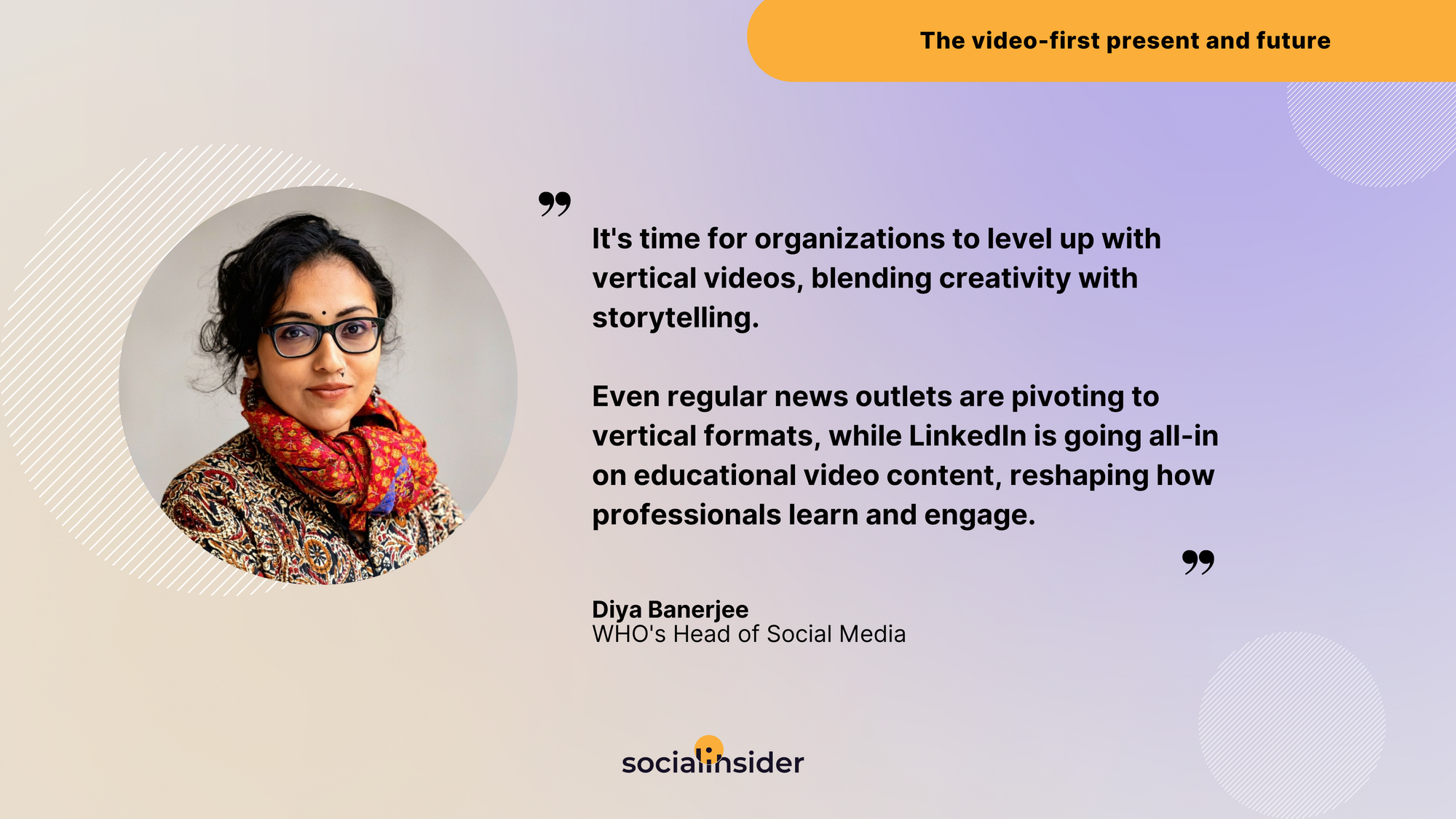
The impact of video is backed by concrete data, as Michal Sklar, Social Media Manager at UserWay & Level Access, points out:
Short-form video content generates 1200% more shares than text and images combined. Whether you're scrolling on TikTok, Reels, Shorts, or even LinkedIn – it's clear that this format isn't just a trend, it's the future of how we engage audiences.

Marketing Manager Emily Crowe adds a business perspective:
Short-form video will continue to merge with SEO as consumers increasingly use TikTok, Shorts, etc. to inform their decisions. The potential to organically drive awareness through engaging, customer-focused videos will be a boon to brands who tap it—exciting news, particularly for smaller businesses and solopreneurs with lean advertising budgets.
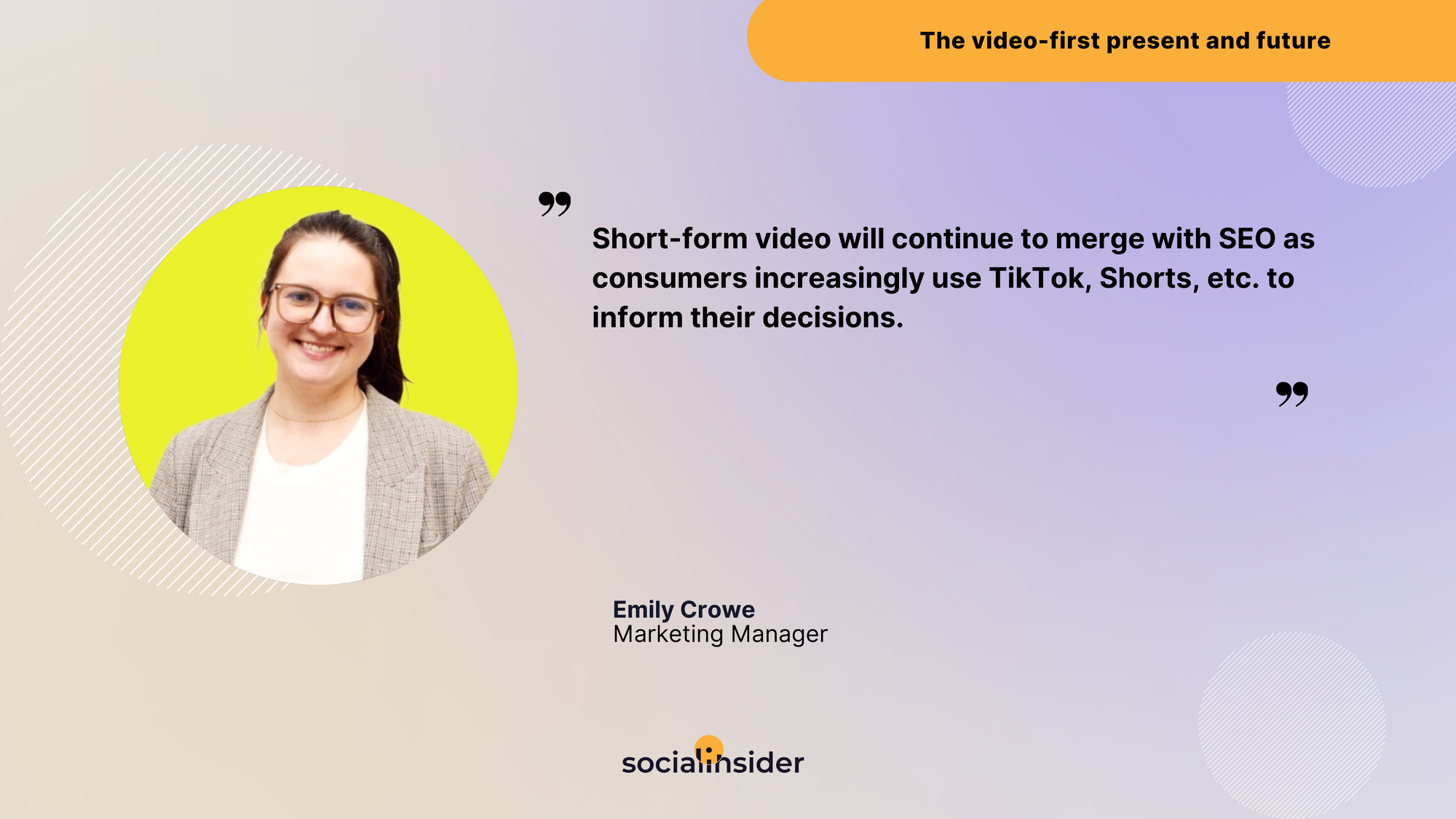
Are you among the brands mastering video marketing? If not, it's time to act:
- Create platform-specific video content that respects each channel's unique characteristics, whether for Reels, TikTok, or YouTube Shorts.
- Blend long educational videos with shorter series that break down complex topics into digestible video segments.
- Use the vertical format for a native mobile viewing experience.
- Incorporate text overlays for silent viewing preferences.
- Optimize thumbnails and first frames to get more reach and engagement.
Trend #16. The AI takeover in social content
The conversation about AI in social media has changed from "if" to "how much." Social media specialists are discovering that success lies in strategically blending AI tools with human creativity.
AI will revolutionize content creation, helping brands develop highly personalized posts, captions, and visuals. While automation speeds things up, the best strategies will balance AI tools with a human touch to retain that all-important emotional connection. - Social Media Specialist Shahveer Imran.
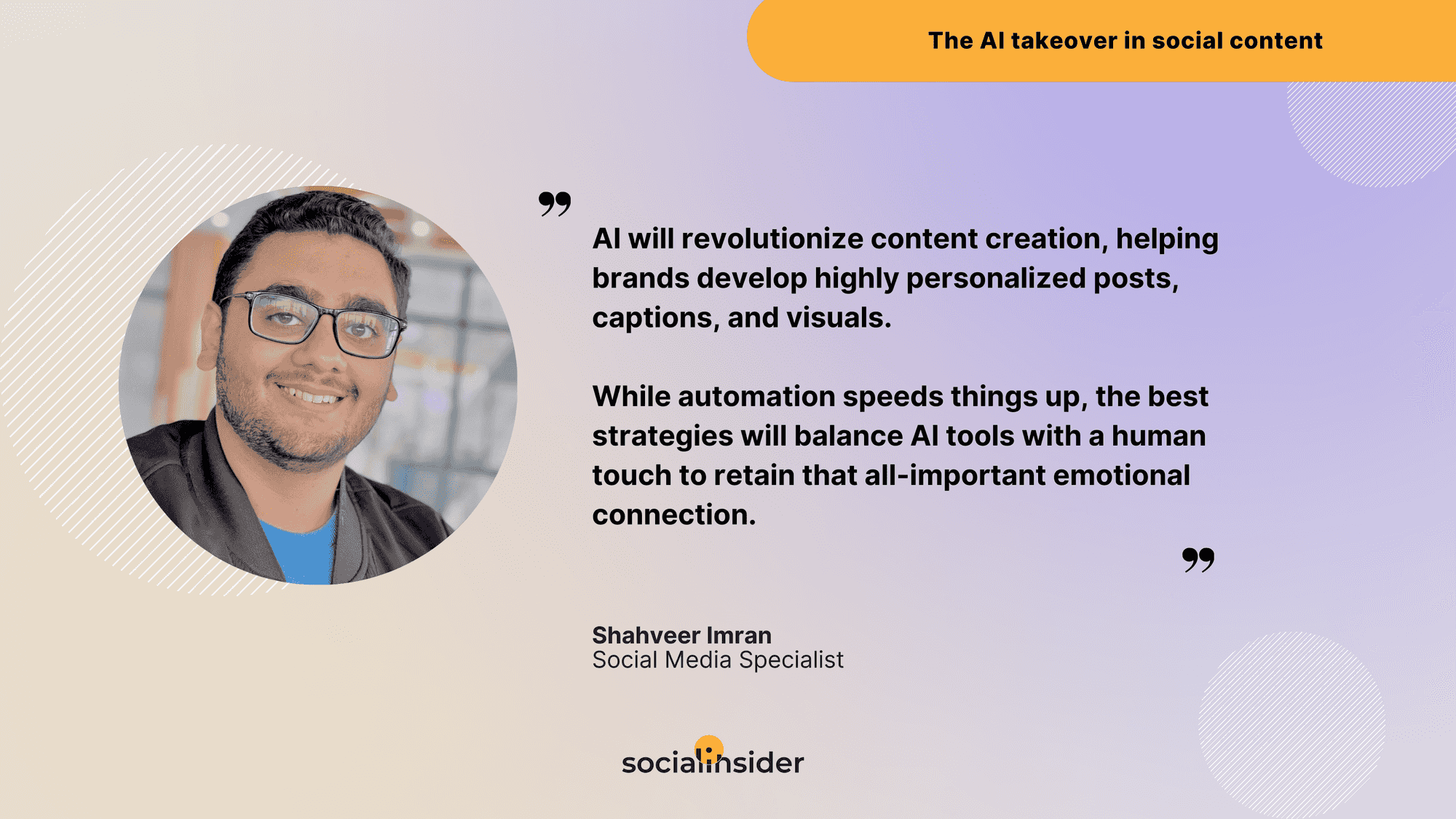
Marketing Specialist Andreea Banu adds:
From editing and rewriting content to generating ideas from zero, AI will be an assistant for content creation. Strategists will also lean on it to plan content calendars and develop strategies.
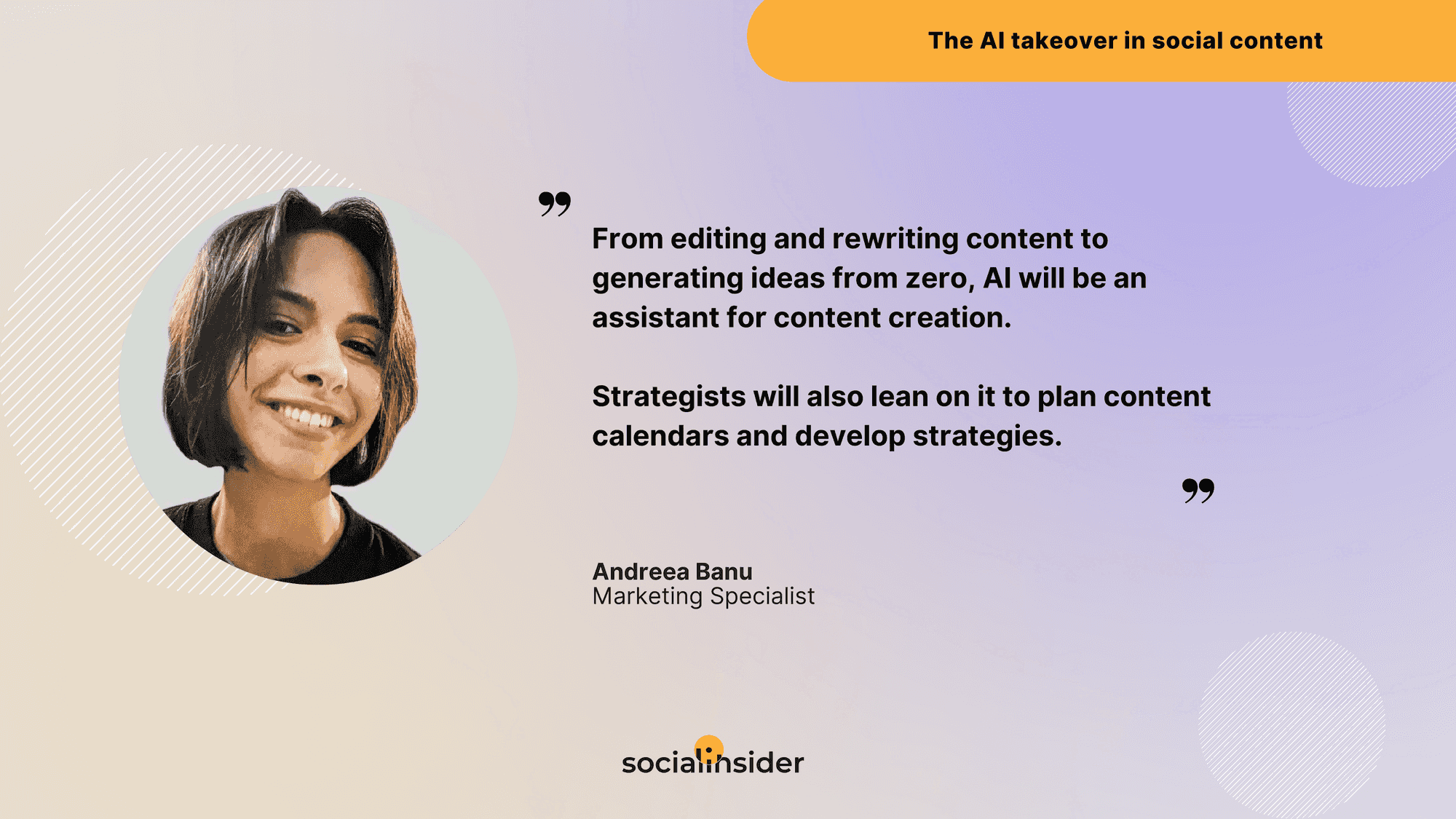
Sr. Social Strategist Gabe Davis makes a bold prediction:
I predict a large consumer brand will go viral // gain a massive following using almost exclusively AI content (because it's good content).
How can brands balance AI and authenticity in 2025?
- Use AI for data analysis and content optimization, such as analyzing top-performing posts to identify winning patterns.
- Implement AI tools for ideation while maintaining human oversight for overall quality, tone, and brand voice.
- Leverage AI for personalization at scale, creating dynamic content variants for different audience segments and platforms.
- Deploy AI chatbots for initial community management but keep human interaction close by.
- Use AI to identify social media trends and content opportunities before they peak.
Trend #17. The social media ROI maximization
For a long time, marketers couldn't really measure social media ROI and prove its efficiency in driving business growth. And that time is finally gone.
Social media-driven marketing is moving beyond vanity metrics to become a powerful support for all business goals, from awareness to sales — and there's data to back it up.
As Adina Jipa, Co-Founder & CMO at Socialinsider, explains:
Social media-driven marketing will dominate in 2025, as platforms evolve into powerful ecosystems for personalized engagement, data-driven insights, and seamless customer journeys. Moving beyond vanity metrics like followers, marketers will prioritize authenticity and meaningful interactions to foster deeper connections and drive sustainable growth.

To use social media effectively for business growth, you first have to understand what works and what needs optimization:
- Set up conversion tracking across all social platforms and align with CRM data.
- Measure customer journey touchpoints from social media to purchase.
- Create custom ROI dashboards that connect social activities to revenue generation.
- Leverage dedicated social media analytics tools that centralize data and offer powerful insights and dashboards.
Trend #18. The data-driven personalization imperative
The future of social media engagement lies in sophisticated content personalization, driven by detailed social media analysis.
A sample from Socialinsider's content analysis shows how breaking down content performance by category can reveal unexpected engagement patterns.
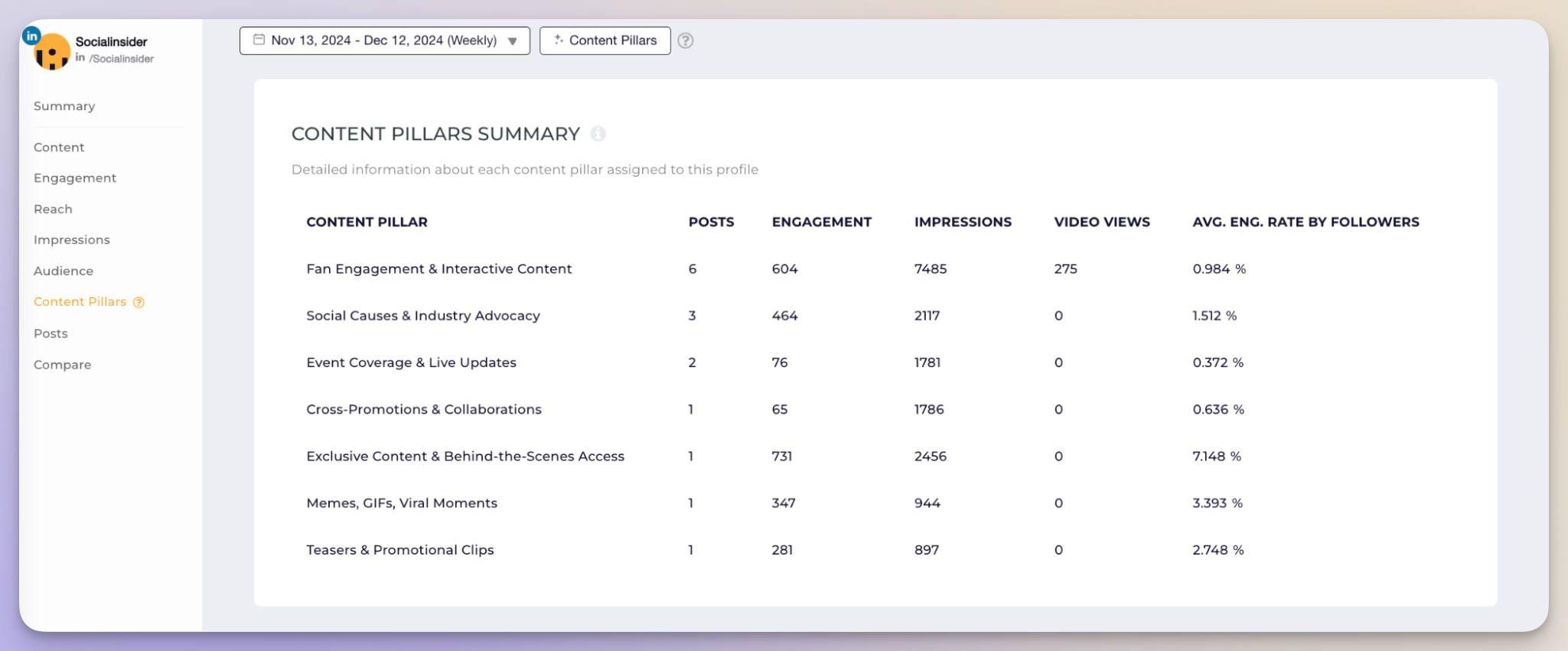
Looking at the brand's content pillar analysis, we can see patterns that challenge posting assumptions. While Fan Engagement & Interactive Content leads in volume, Exclusive Content shows the highest engagement rate despite having only one post.
This kind of analysis demonstrates how content preferences aren't always aligned with posting frequency, highlighting opportunities for strategic content adjustment.
Here's how brands can leverage analytics for personalization:
- Map your content categories against both engagement rates and impressions to identify optimization opportunities.
- Scale up high-performing but underutilized content types.
- Adjust posting frequency based on engagement rate patterns.
- Create targeted content plans based on observed customer preferences.
- Use engagement metrics to inform customer service focus areas.
Trend #19. The dominance of zero-click content
Social media platforms (and users) are increasingly rewarding content that delivers value without requiring people to leave the platform. This means you must abandon the well-ingrained practice of including links in your posts — we know, that's hard 🤗.
Brands need to get used to delivering complete insights within their posts rather than using social media merely as a traffic driver to external resources.
This social media trend reflects a broader change in how professionals consume information, with many preferring to get their insights directly within their social feeds.
2025 will be the year of zero-click content, and especially B2B brands must learn how to do it if they want to remain relevant:
- Create carousel posts that tell complete stories.
- Design infographics that deliver full insights without requiring external clicks.
- Use multi-image posts to break down complex topics step-by-step.
- Develop video content that answers questions completely within the platform.
- Structure posts to deliver immediate value while building platform loyalty.
Trend #20. The AR virality effect
Augmented reality may have sounded like a novelty feature a few years back, but it's becoming one of the most powerful social media trends in 2025.
As AR features become more sophisticated and accessible, they're proving particularly useful in contexts where complex products or abstract services benefit from interactive visualization.
A few ways to leverage AR for viral content:
- Develop platform-specific AR filters that showcase your product features or industry expertise.
- Create AR-enhanced LinkedIn posts that bring data visualizations to life.
- Use Instagram and TikTok AR effects to make technical demonstrations more engaging.
- Design shareable AR experiences that encourage user participation and social sharing.
- Incorporate AR elements into your social media event coverage for hybrid experiences.
Trend #21. The sensory marketing wave
The future of social media engagement is moving beyond visual and audio to embrace all senses.
Social Media Manager Rom Ledder explains:
I think we will see an uplift in sensory ads. With haptic feedback and advanced tech, ads that 'feel' (like a vibration when someone scrolls past a product) could create memorable experiences on mobile. Think Japan style advertising brought to the UK/US with scent, sound, touch all at the forefront.
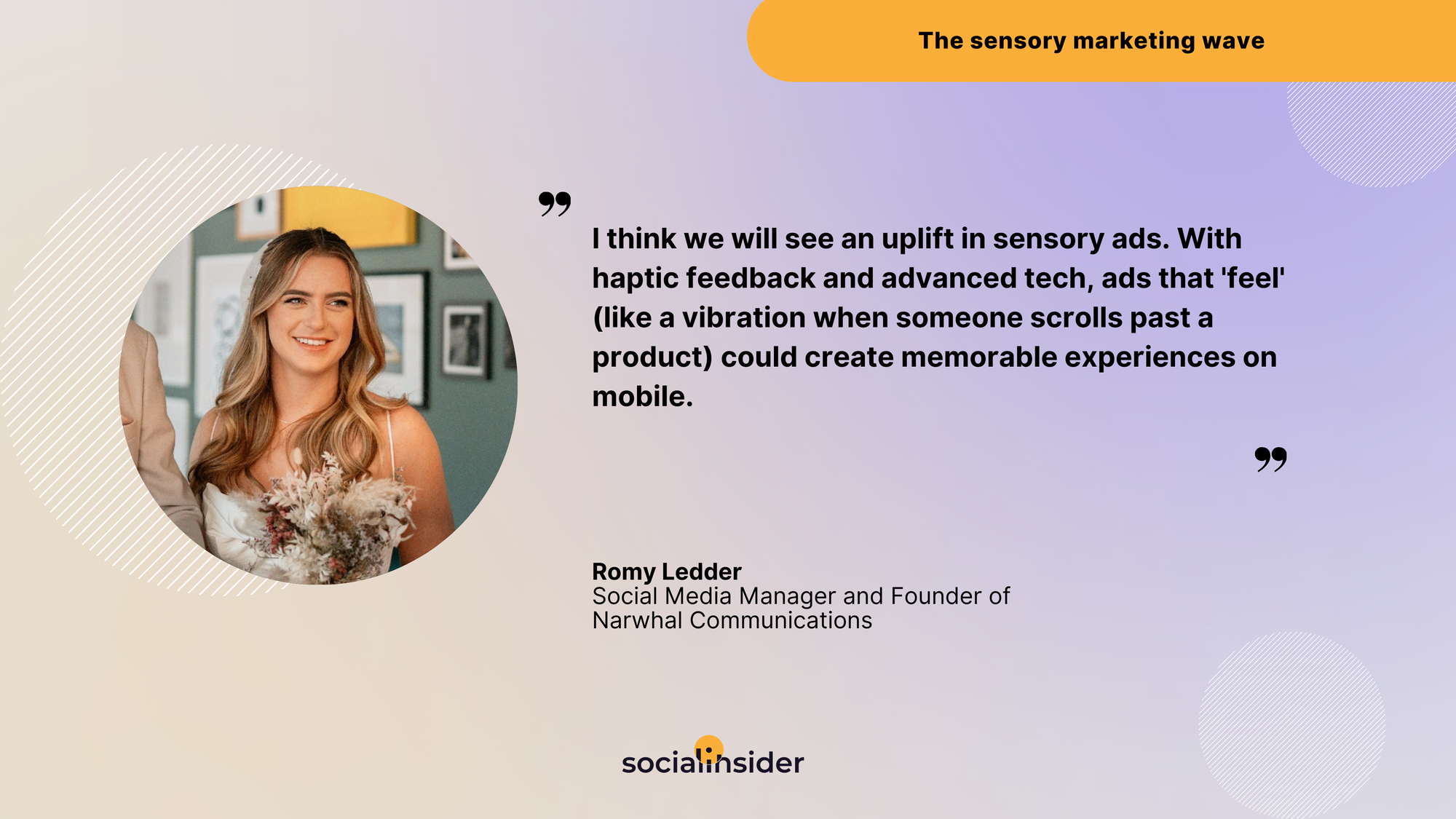
This multi-sensory approach is gaining traction across industries. Dakota Lowe, VP, Social at Edelman, provides real-world examples:
Instead of just social content and OOH, we're now seeing that the more entry points, the better. Take Barbie and Wicked's marketing partnerships, for example. Wicked worked with 400 brands to generate virtually unlimited ways for people to enter into the Wicked universe.
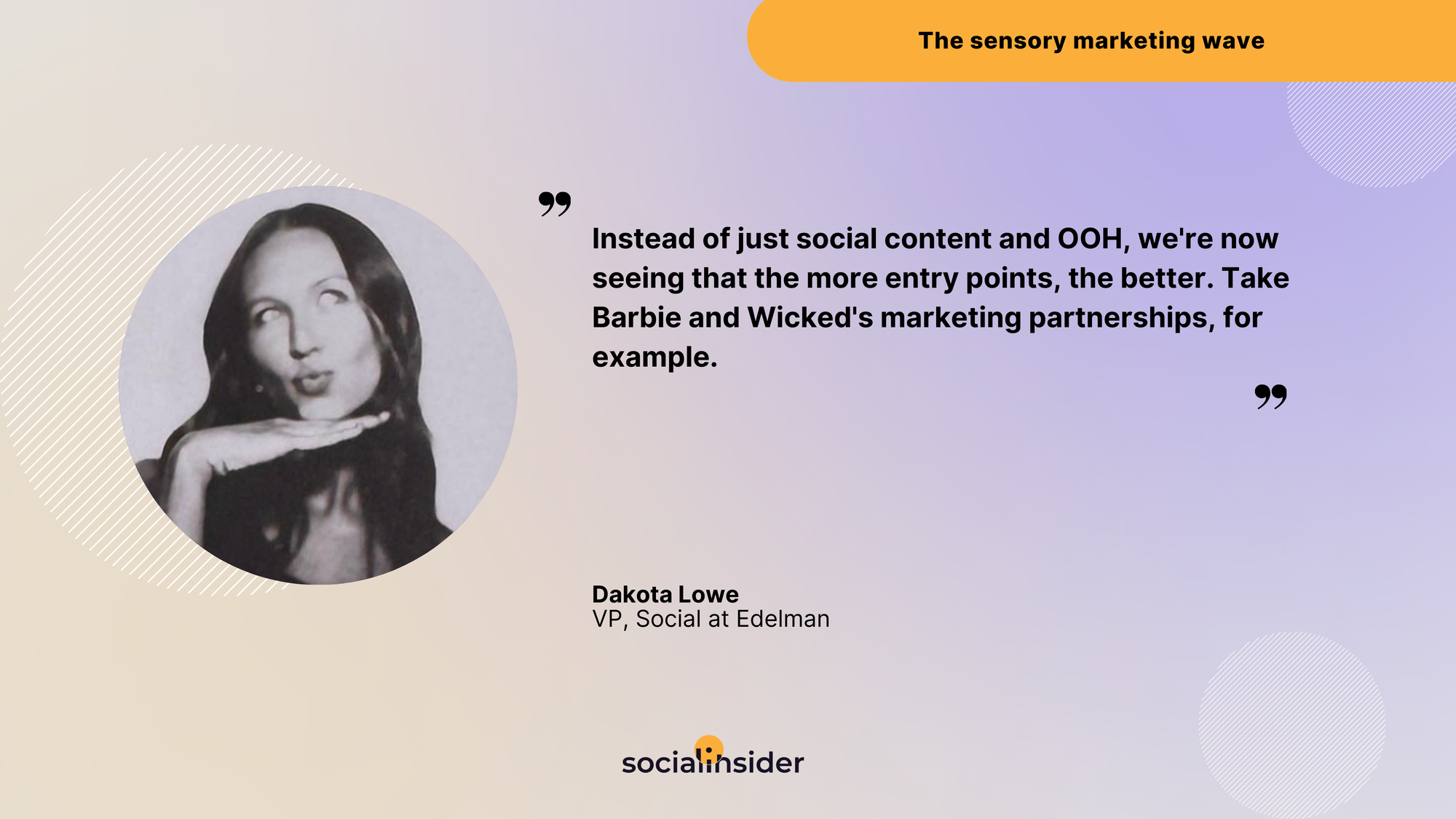
Digital Marketing Strategist Alexandra Nicolae reinforces this transformation:
Brand activations as we know them will be changed for good, and this is truly an interesting shift.
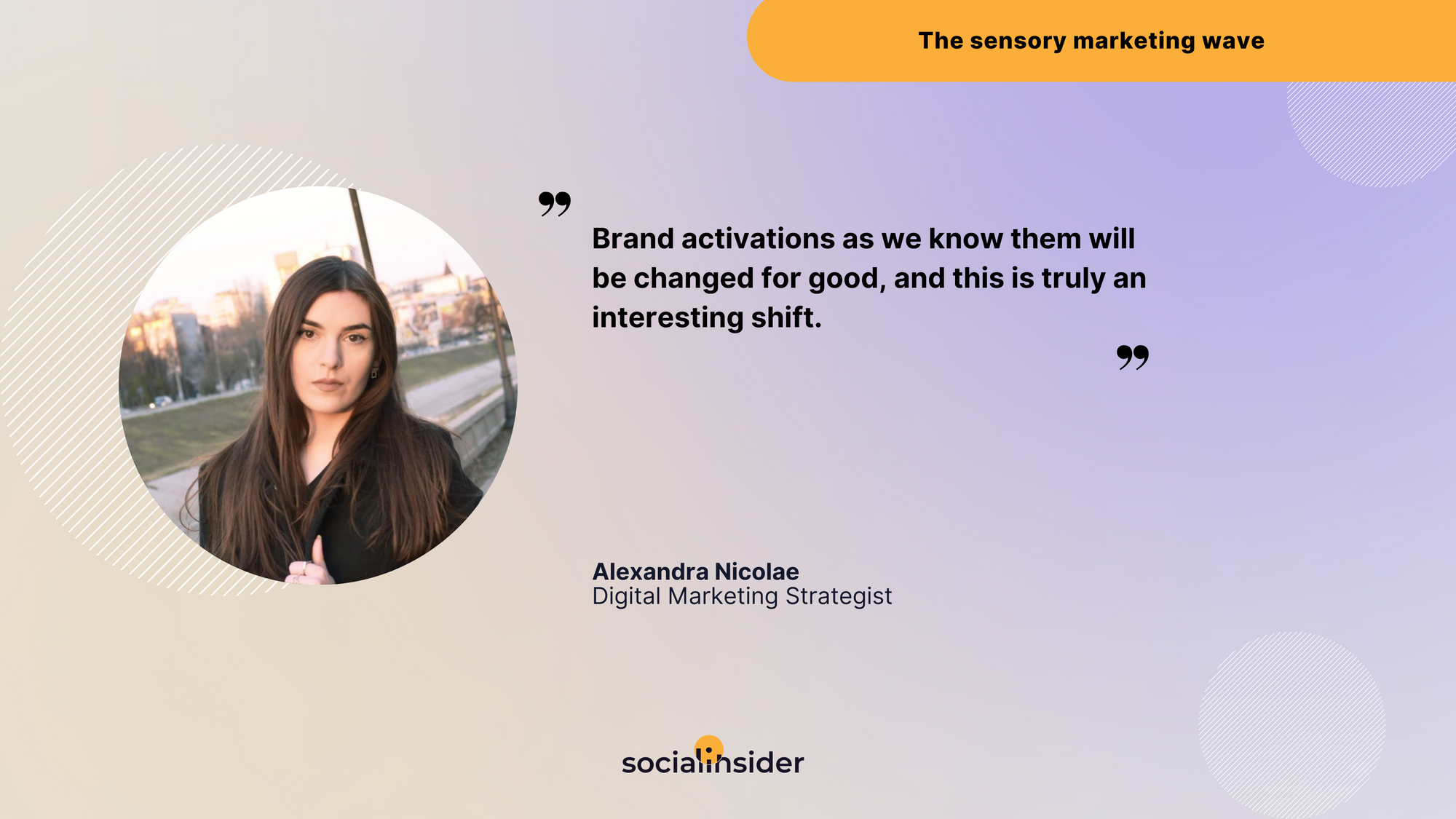
It's time to create a richer social experience for your followers:
- Integrate haptic feedback into mobile social media content, such as vibrations when users swipe through product carousels or tap on interactive elements.
- Combine audio-visual elements in Instagram Stories and Reels, like soundscapes that match visual transitions or ASMR-style product demonstrations.
- Design AR filters that respond to user movements and gestures, adding sound effects or haptic feedback for a more immersive experience
Trend #22. The voice search momentum
Talking about all the senses, social media marketers are adapting their strategies to accommodate the rising influence of voice search.
As Social Media Strategist Dorien Morin highlights:
My top 3 votes for popular trends in 2025 are: short-form video will continue to reign, brands will need to put AI policies in place (for all aspects of business), and voice search market share will continue to grow.
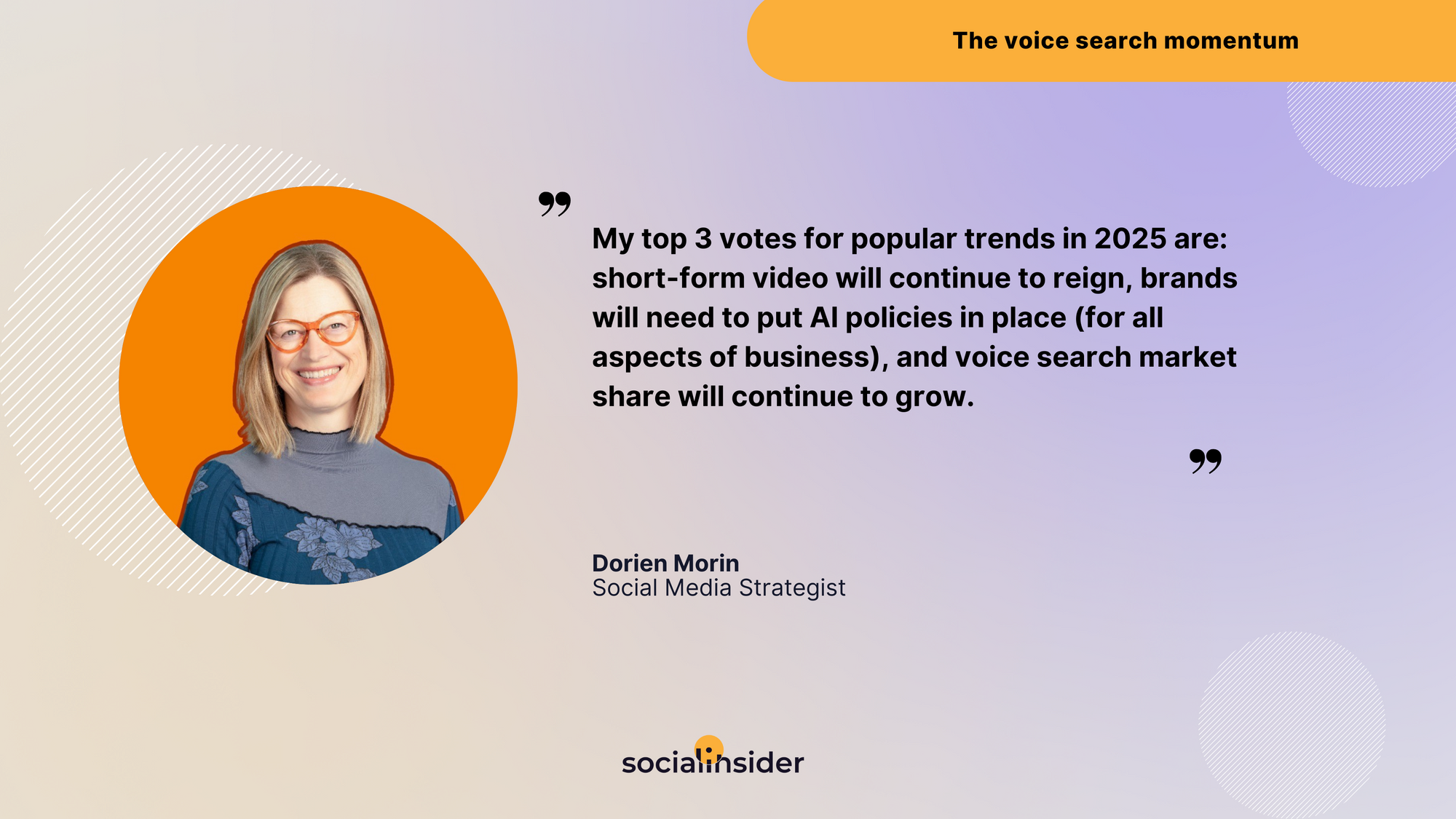
Voice queries differ from typed searches in both structure and intent. Social media content must now be findable through conversational questions rather than just keywords.
Can you hear it? Pay attention to your customers' voices:
- Structure social media captions and descriptions as answers to common voice queries, like "How do I..." or "What's the best way to...".
- Create LinkedIn articles and posts that address specific questions your audience asks through voice search.
- Tag and label visual content with conversational keywords that match natural speech patterns.
- Develop FAQ-style content series that mirrors common voice search queries in your industry.
Final thoughts
Social media is changing fast, but here's the good news: you don't need to adopt every trend at once. Start with what makes sense for your brand and audience. Maybe that's building a stronger community, experimenting with video content, or getting your team more involved in content creation. Whatever you choose, don't forget to keep an eye on social media analytics and improve.
Give Socialinsider a spin with a free 14-day trial. You might be surprised by what social media trends your data reveals.








